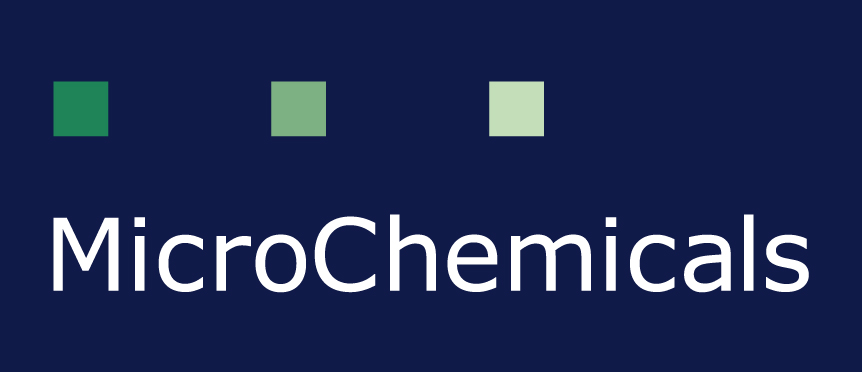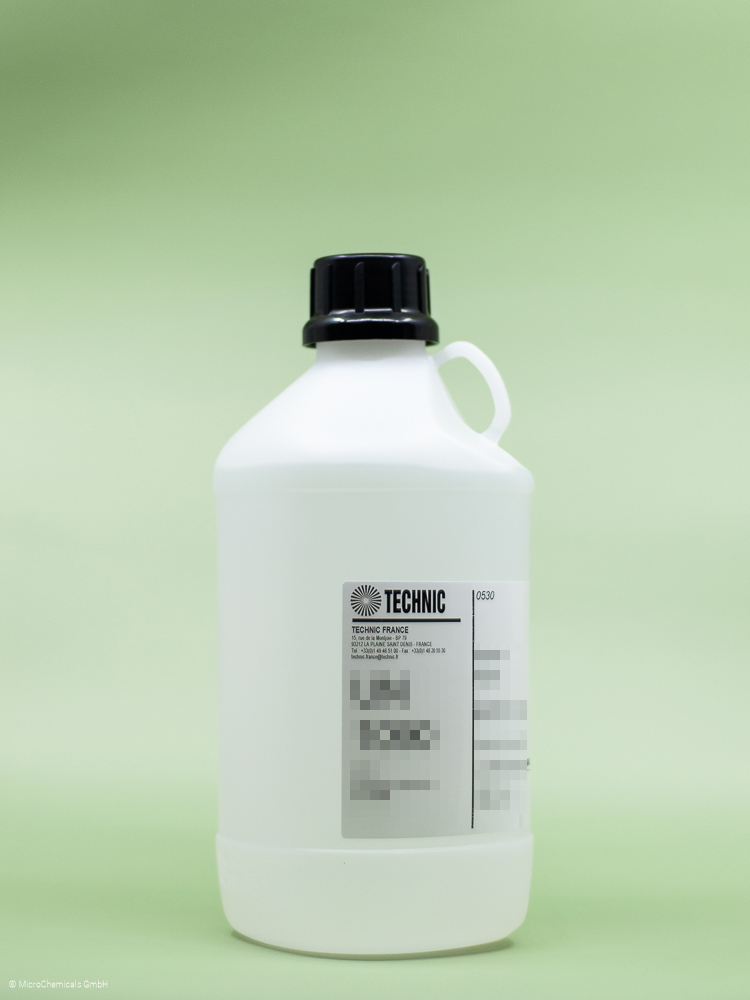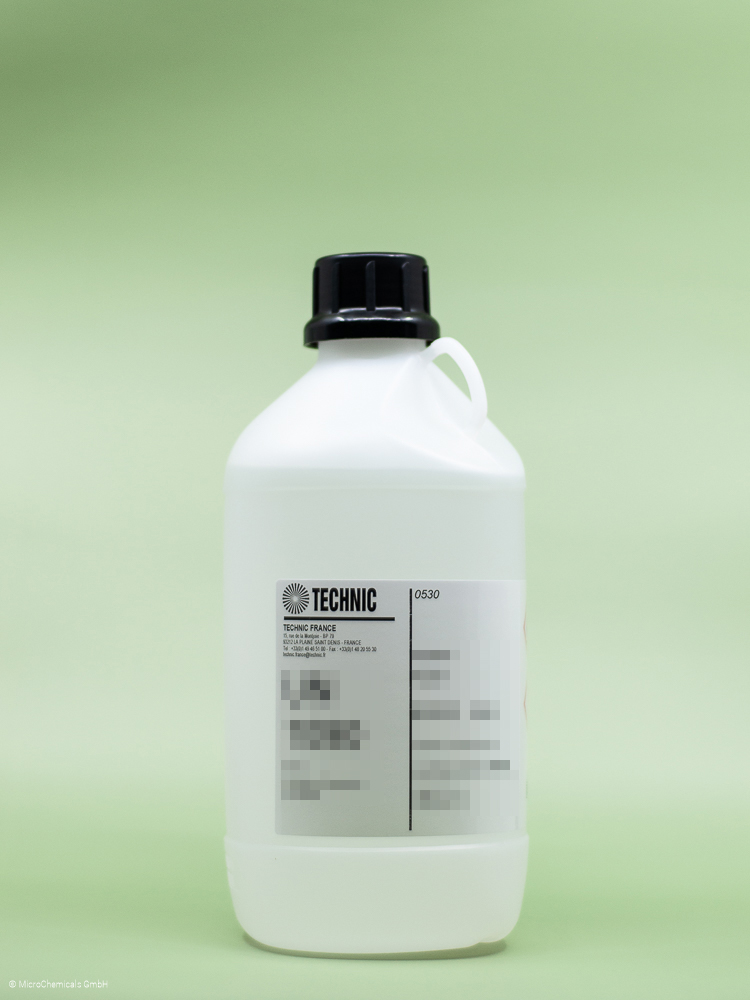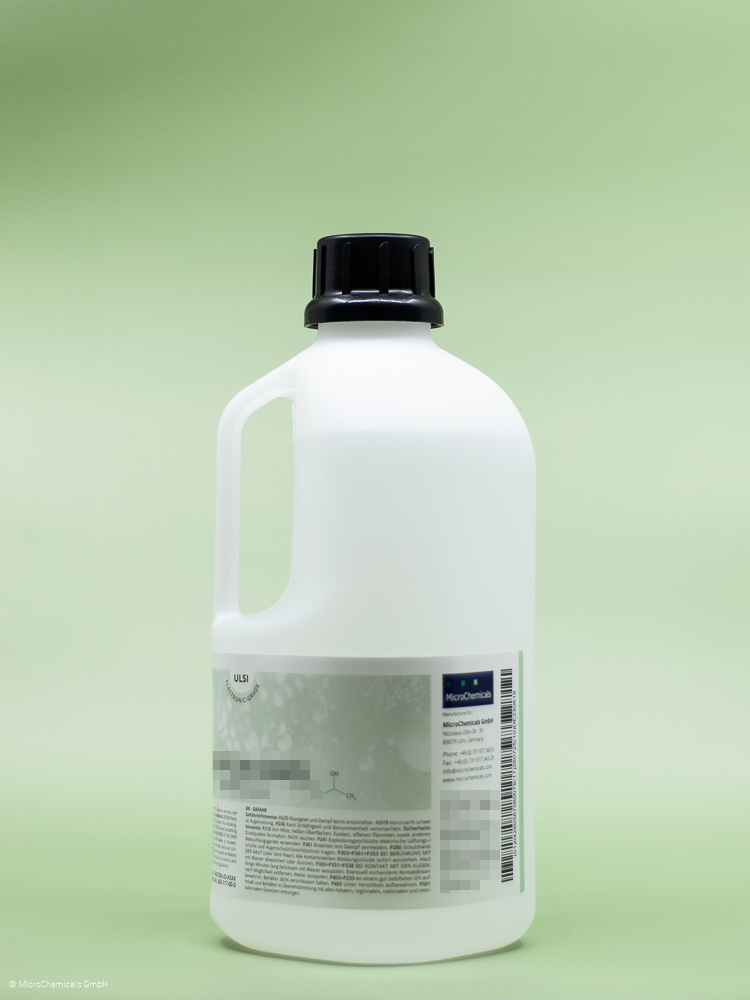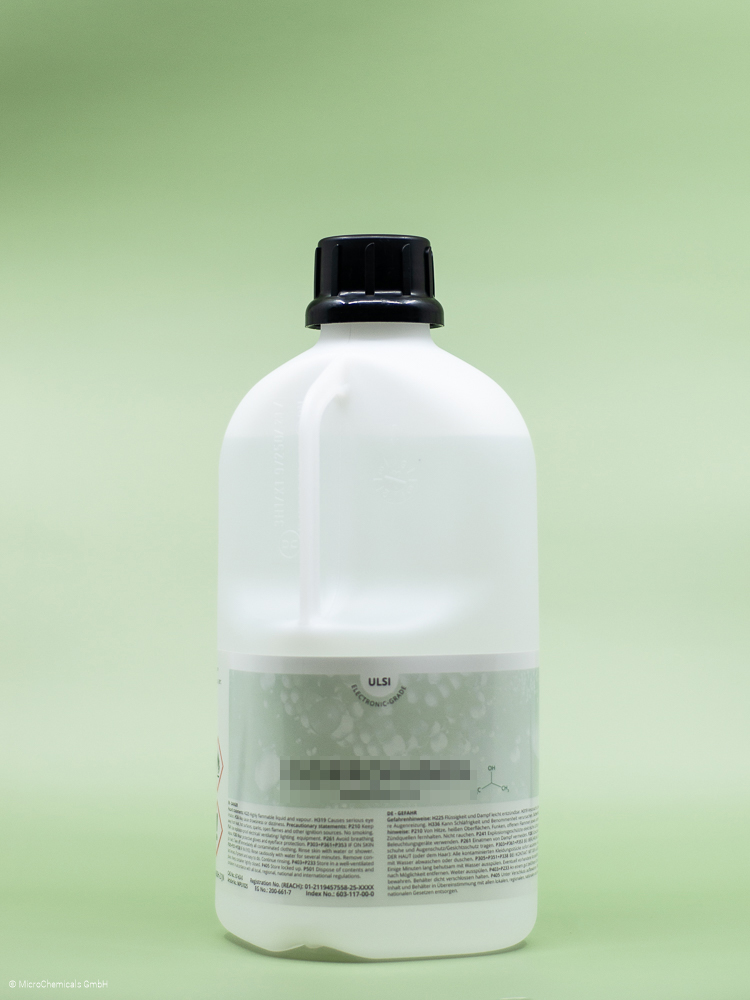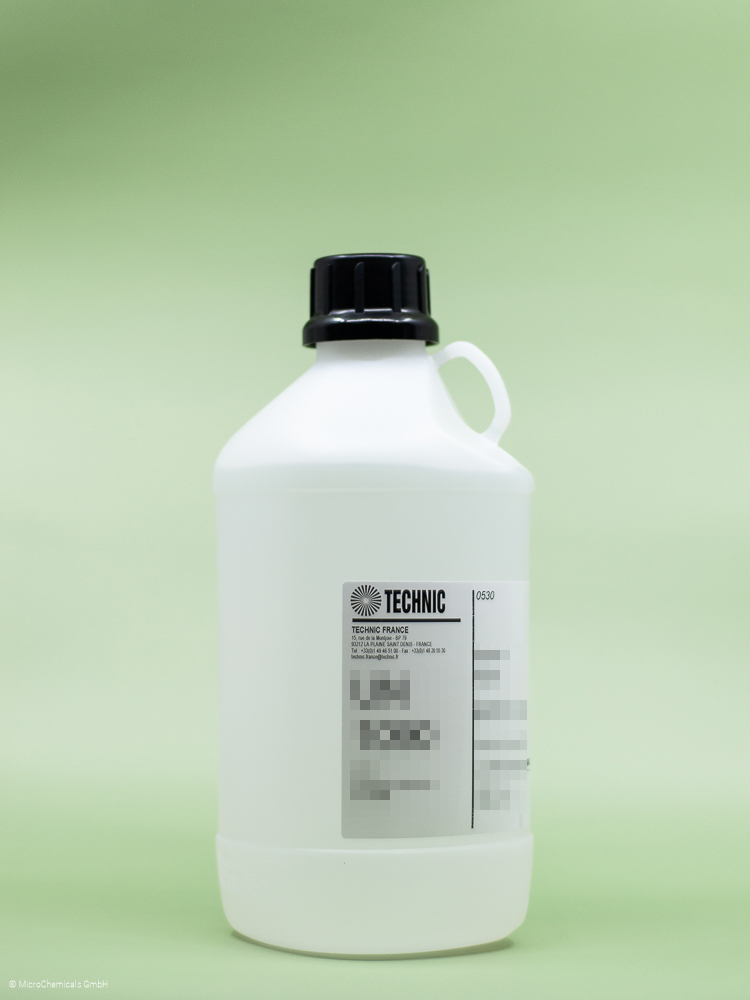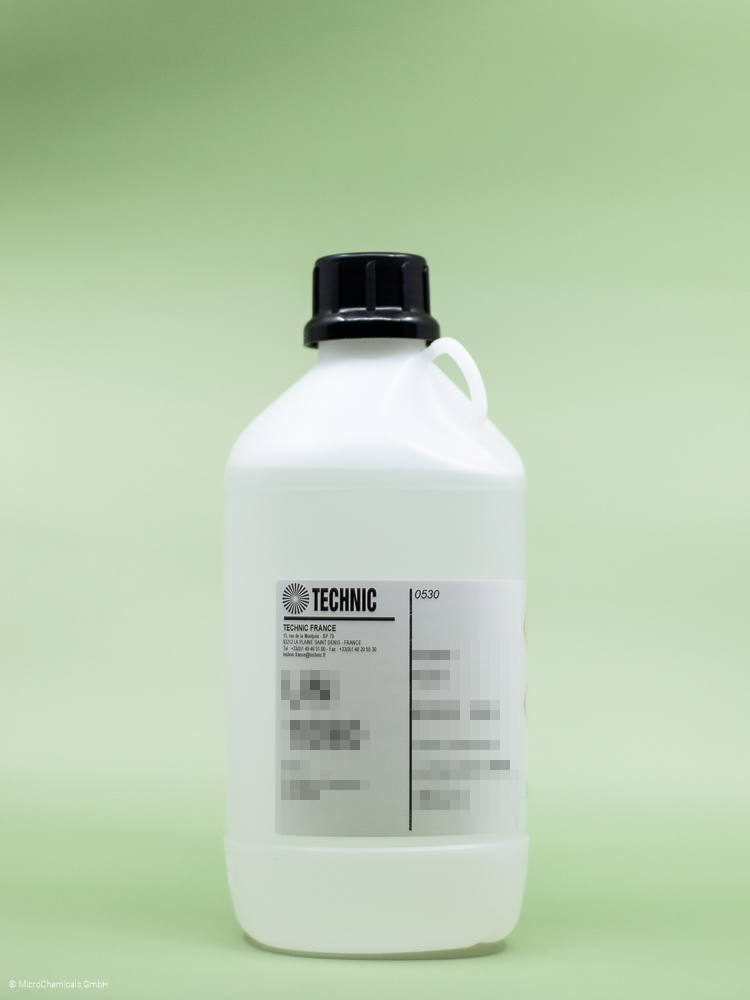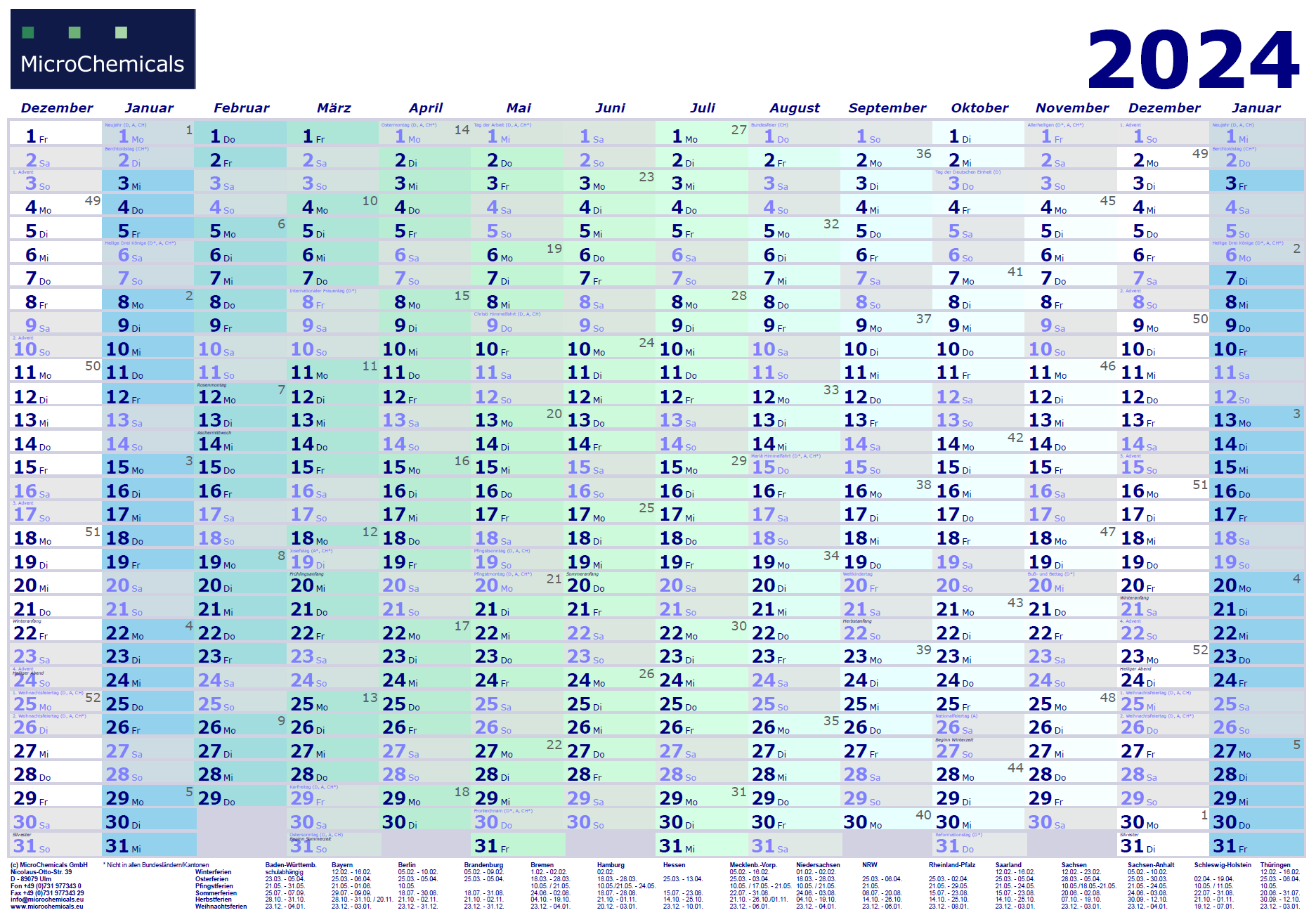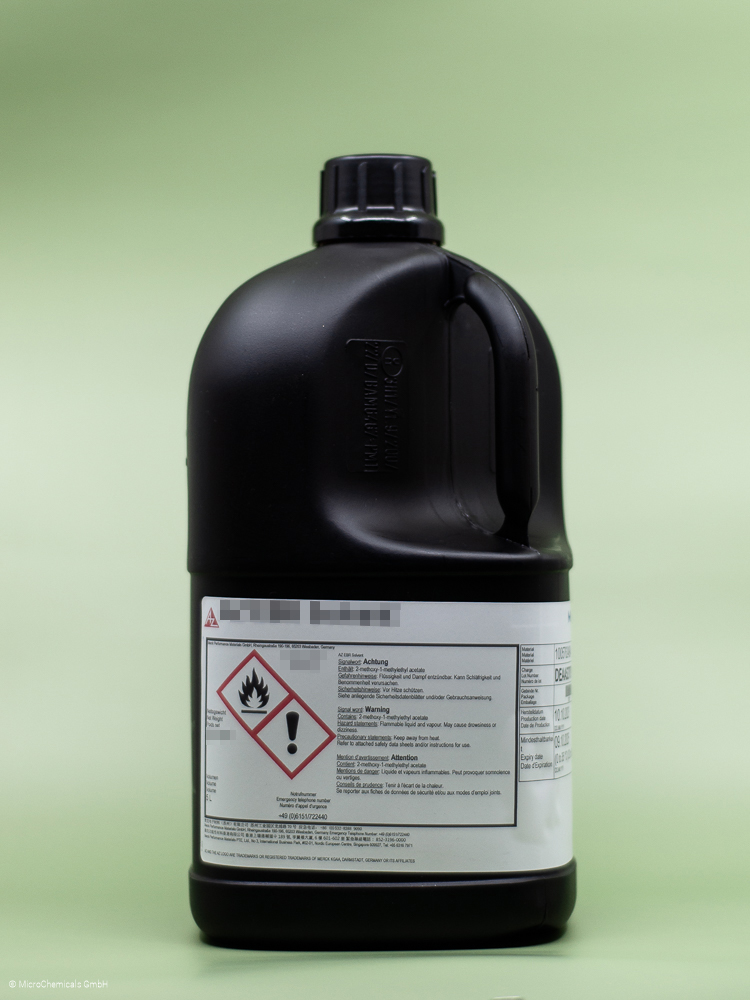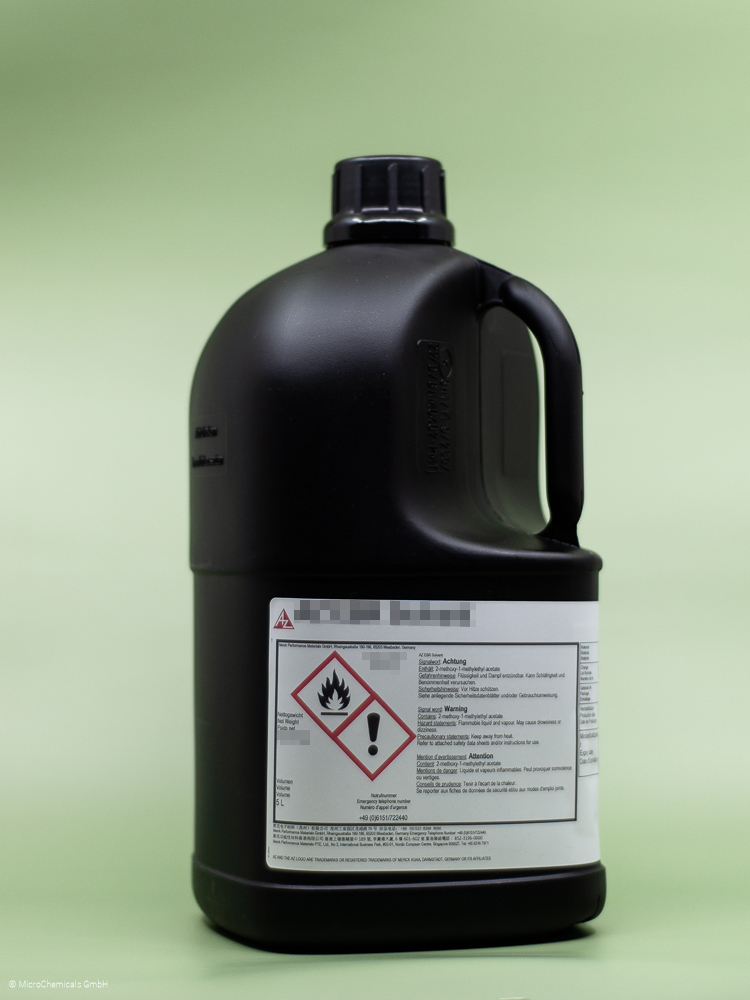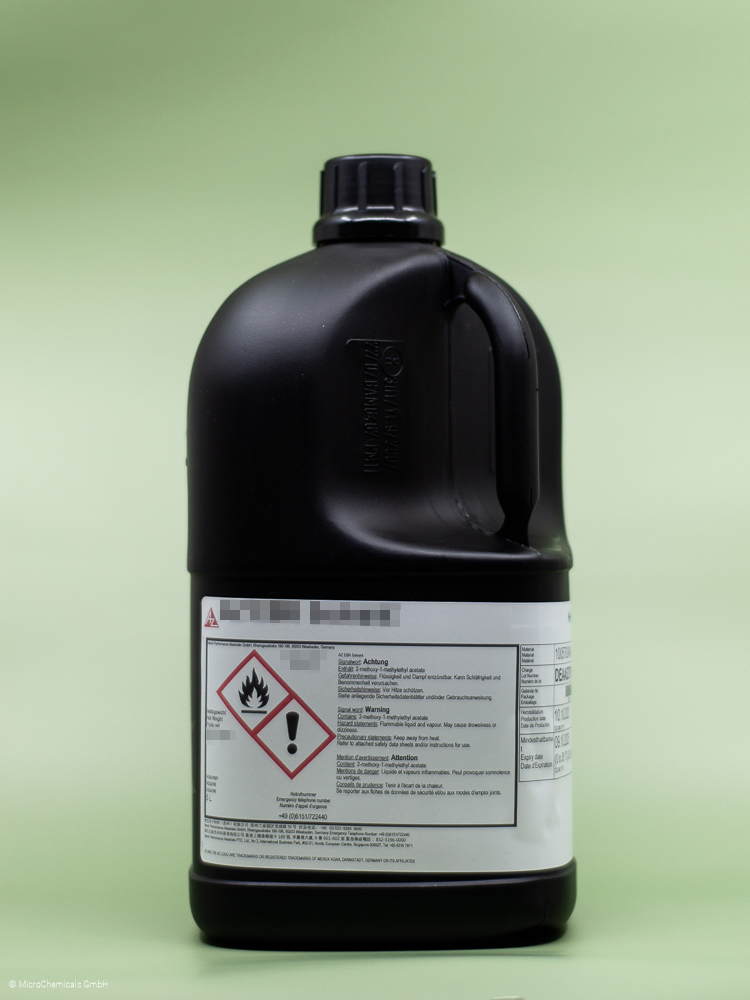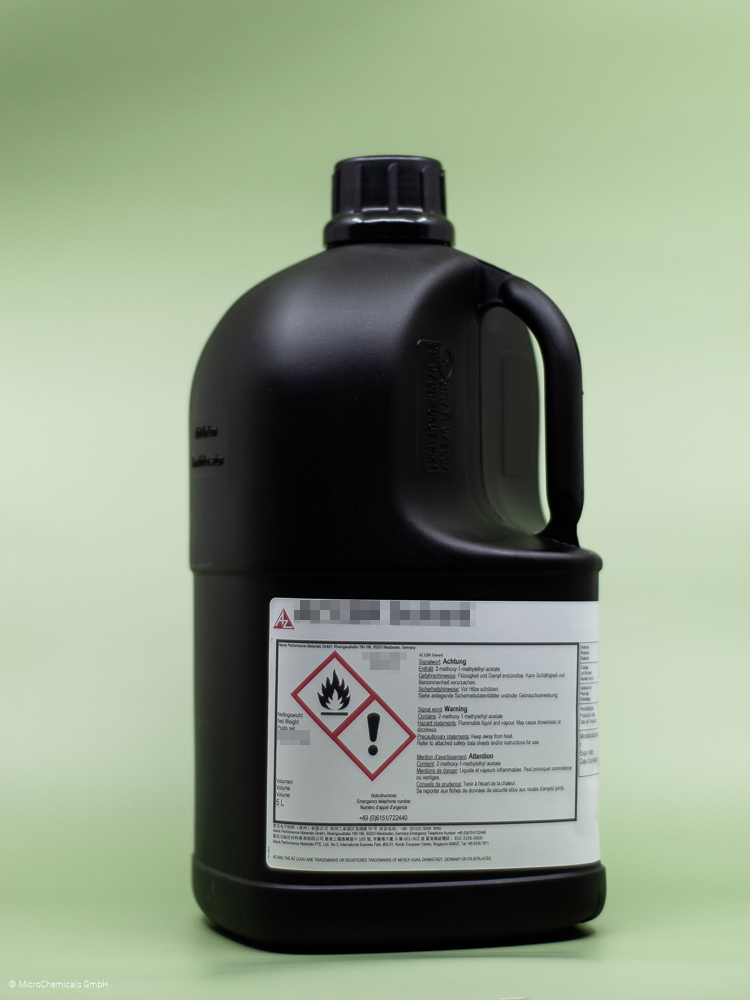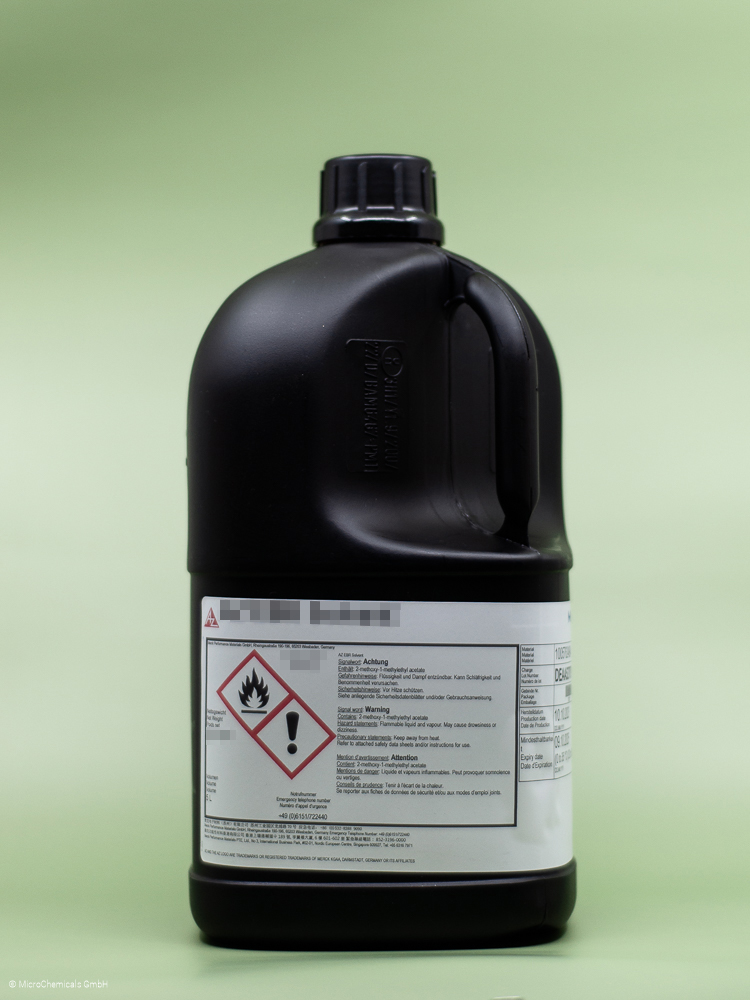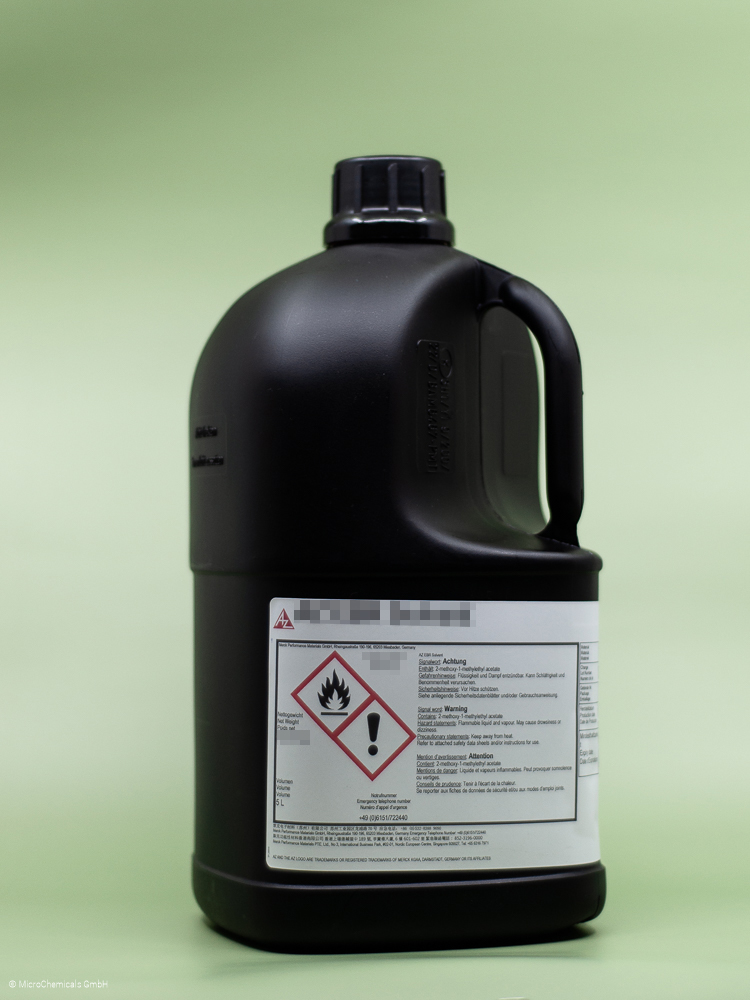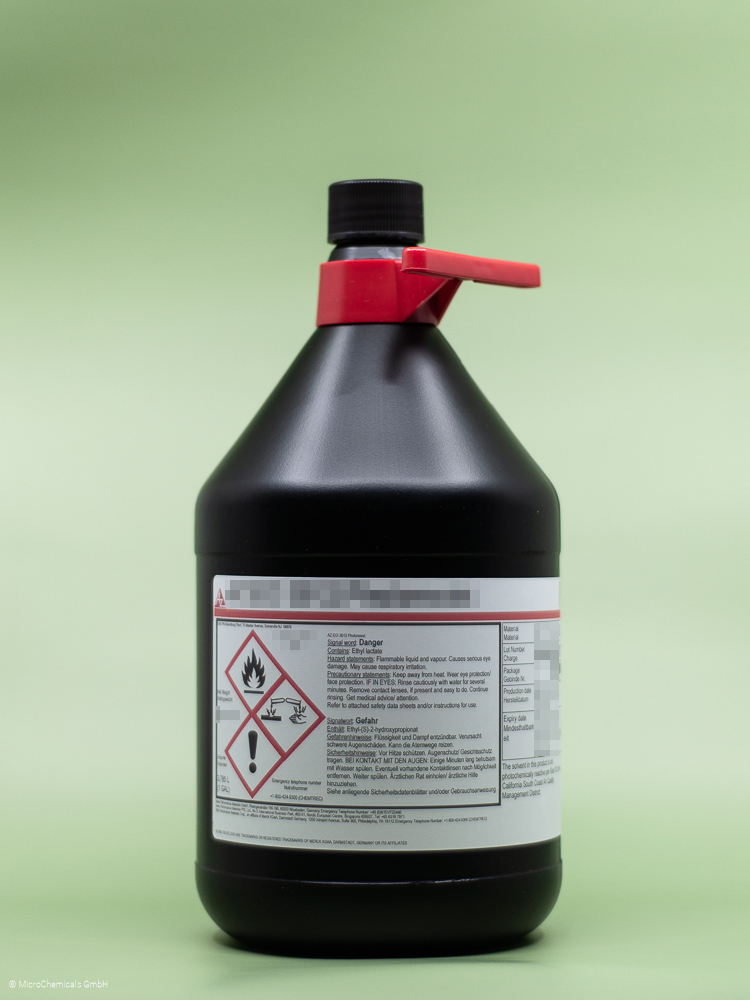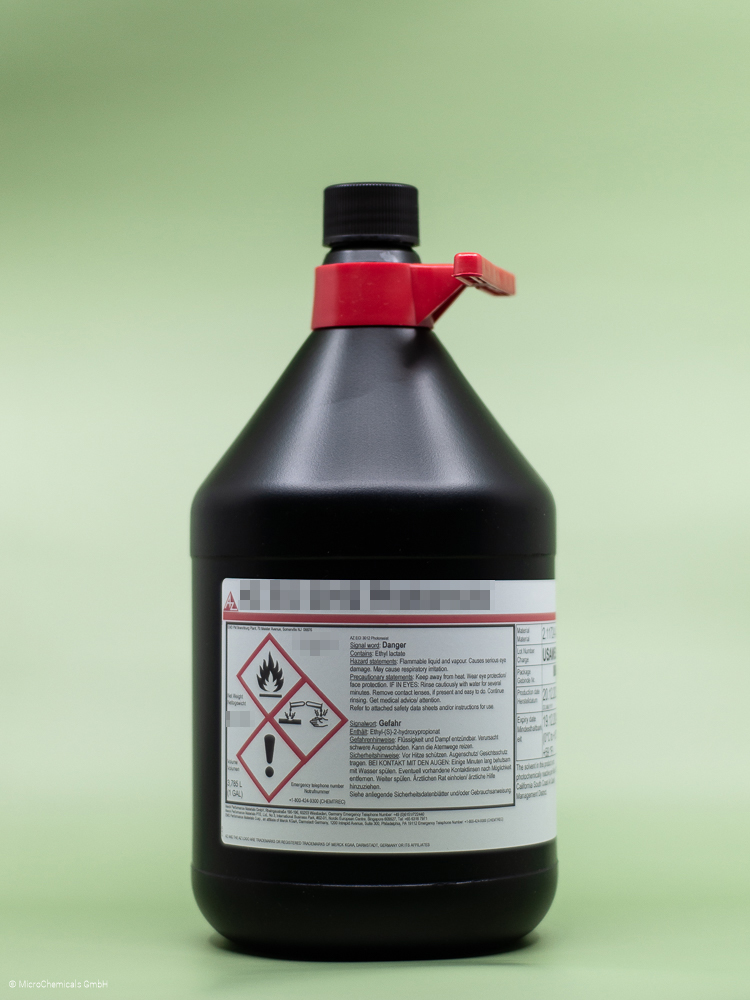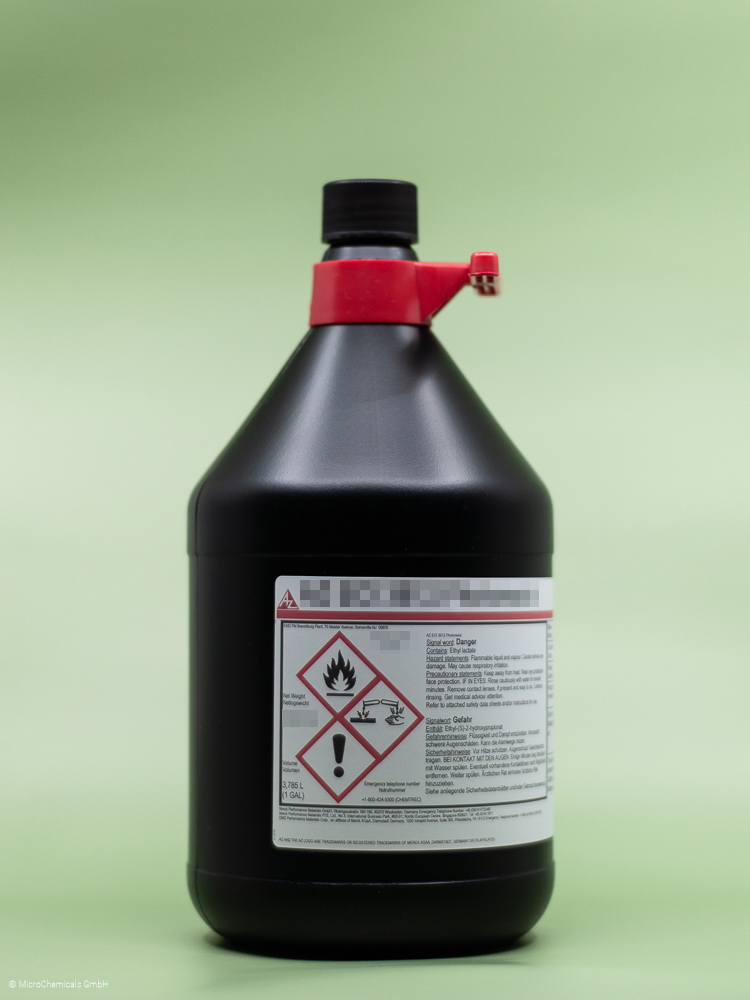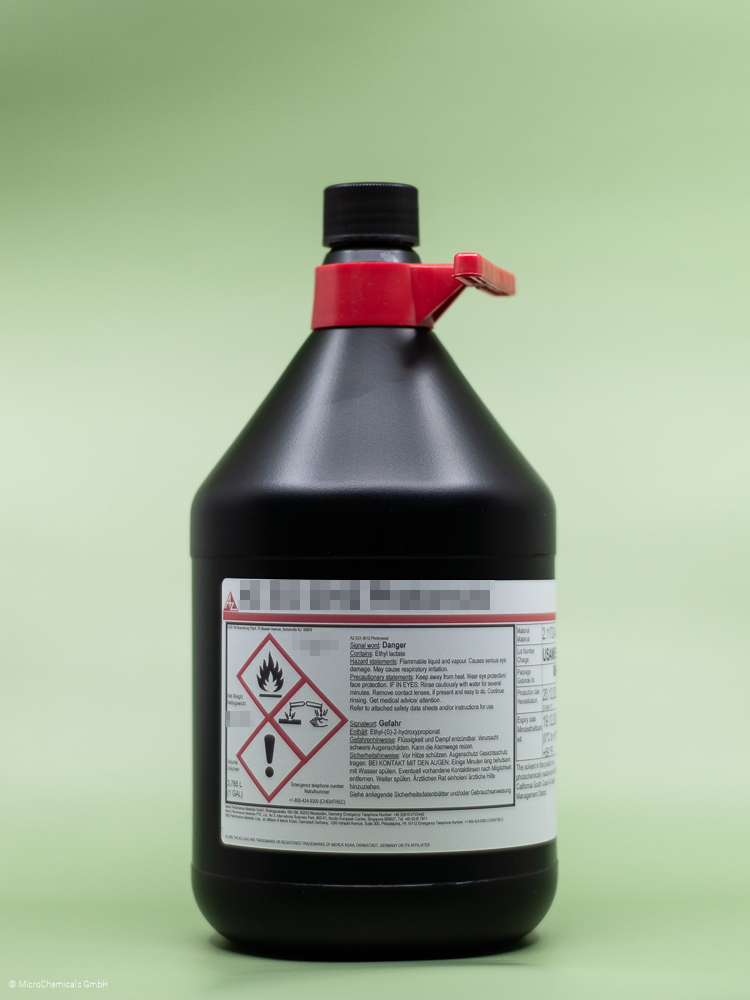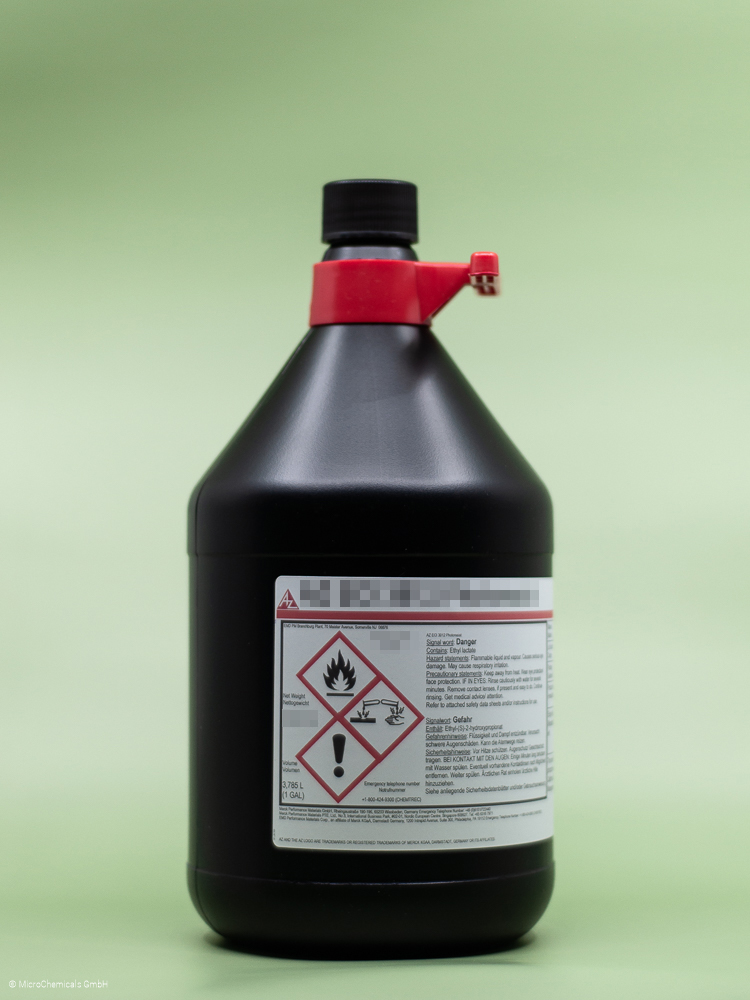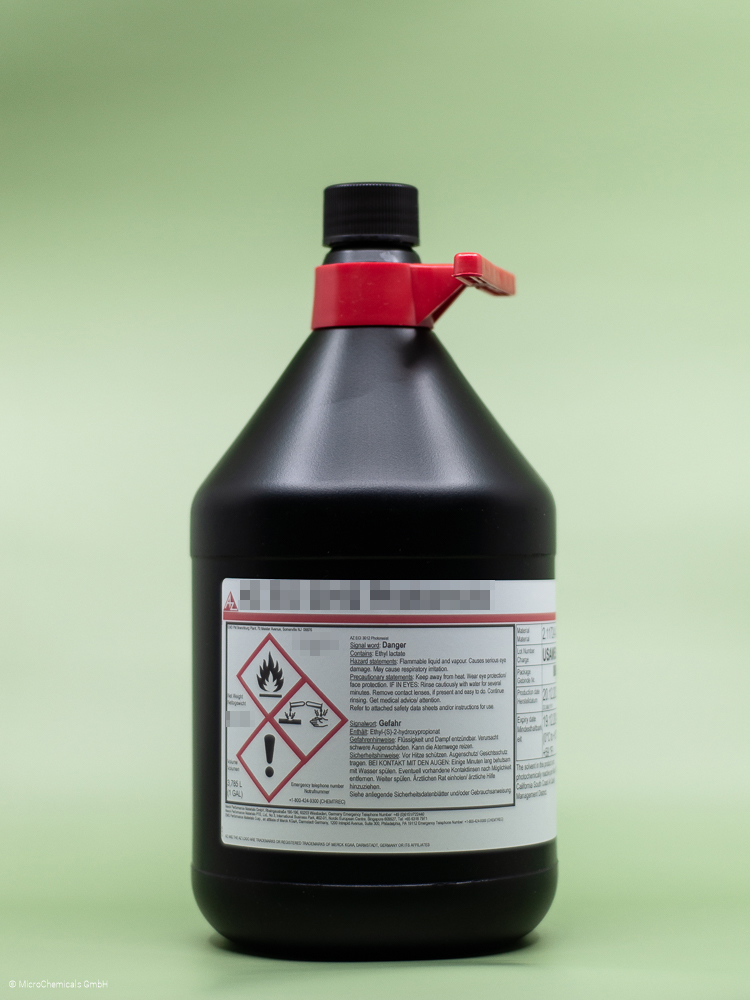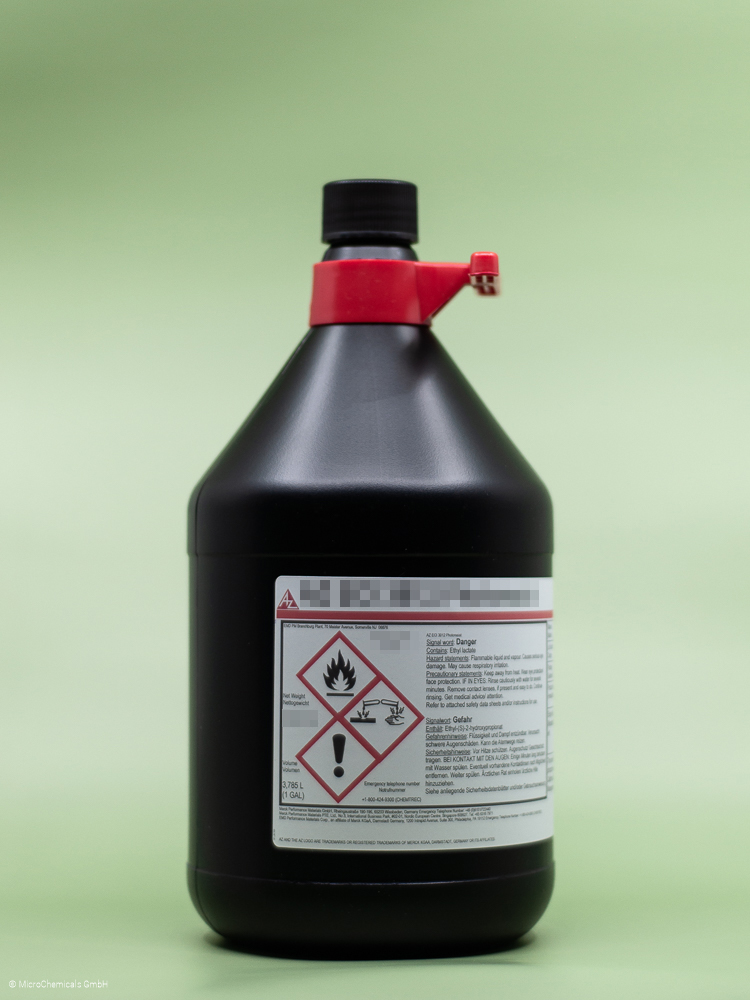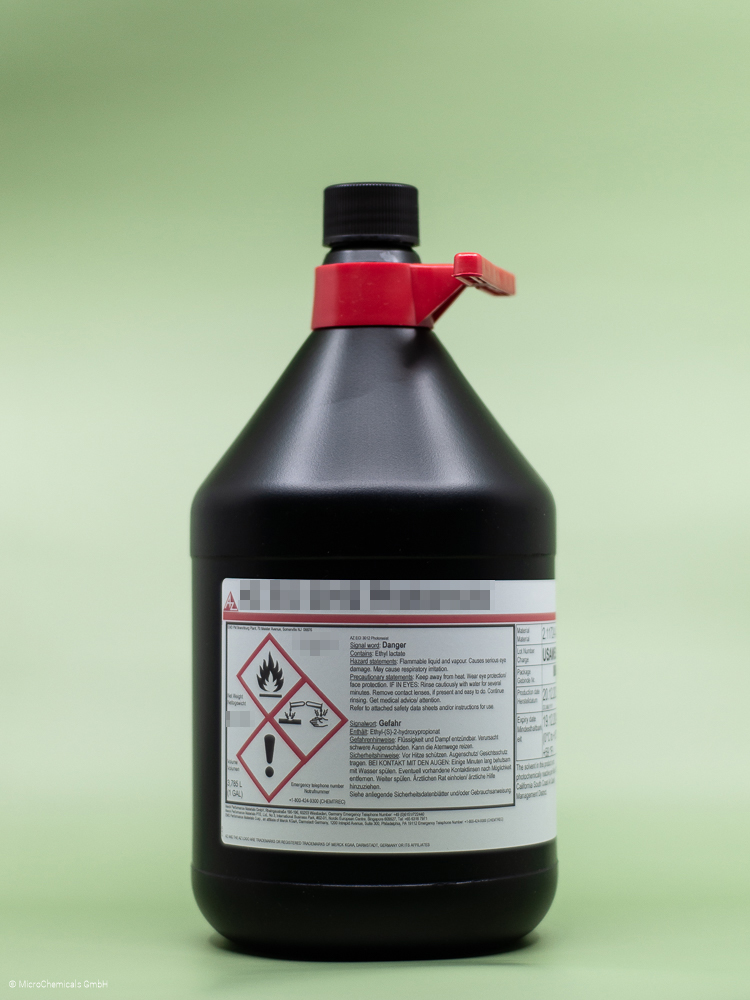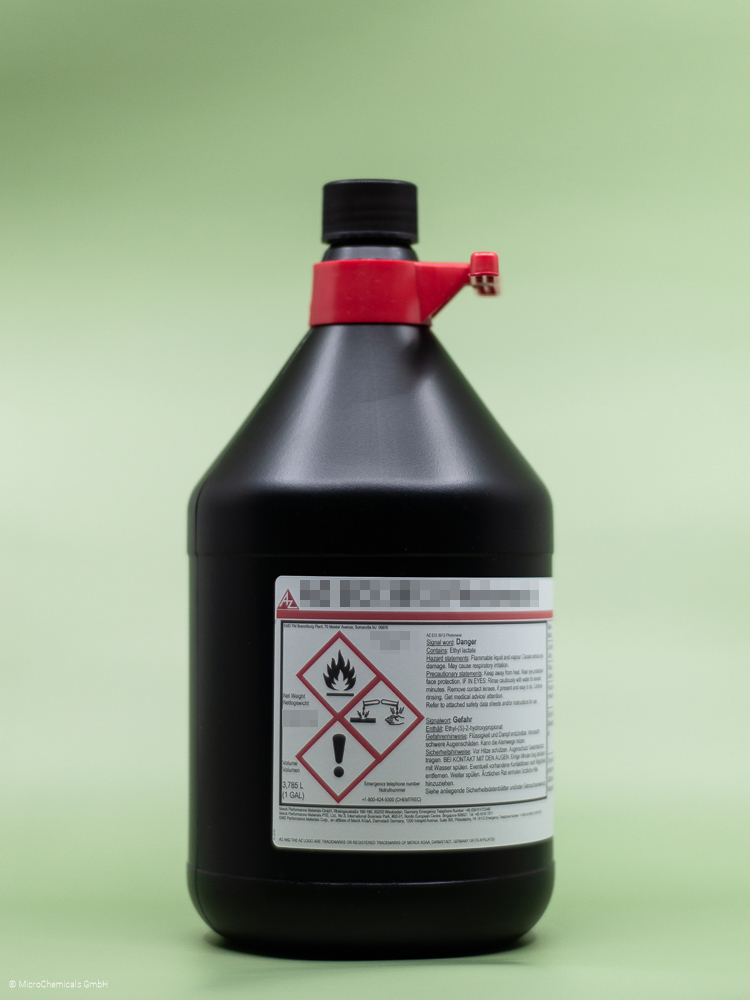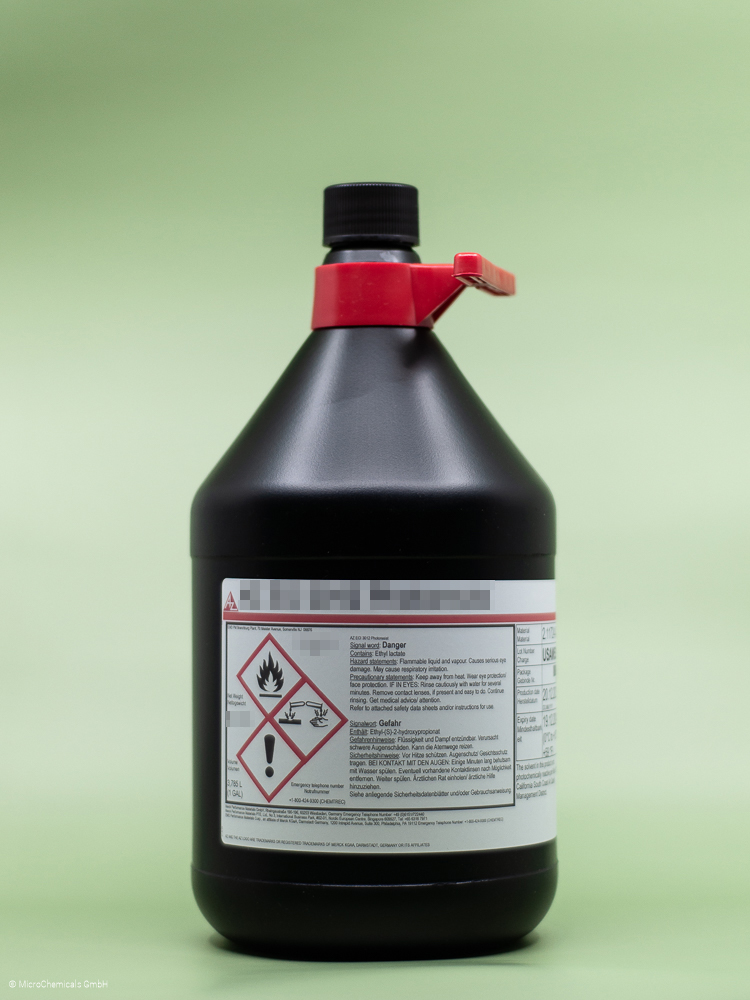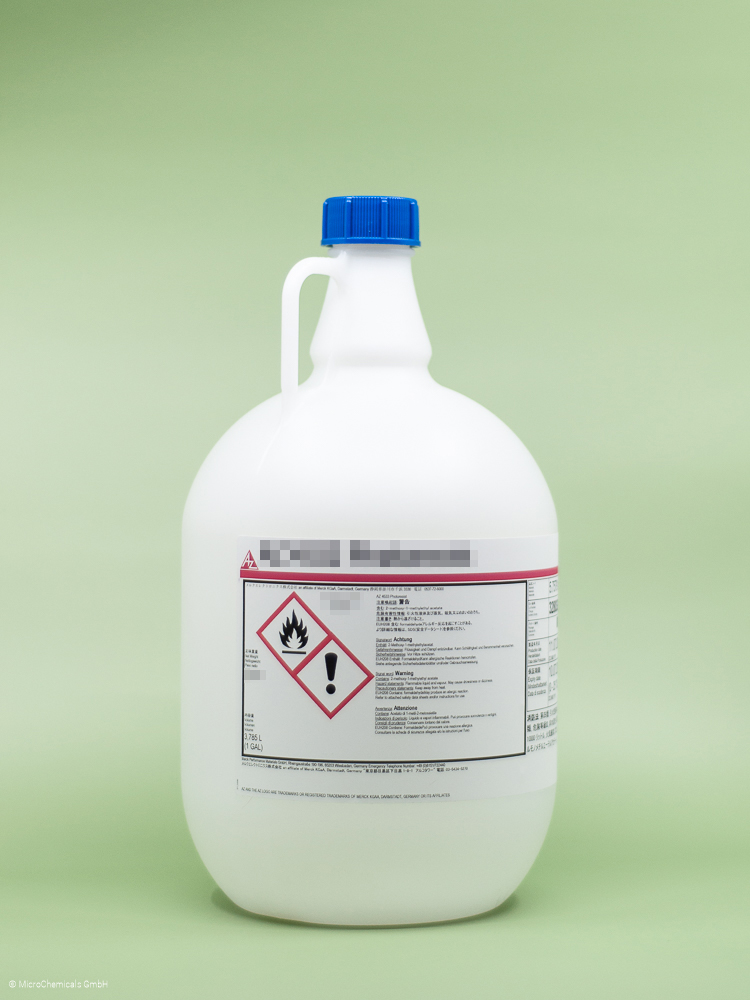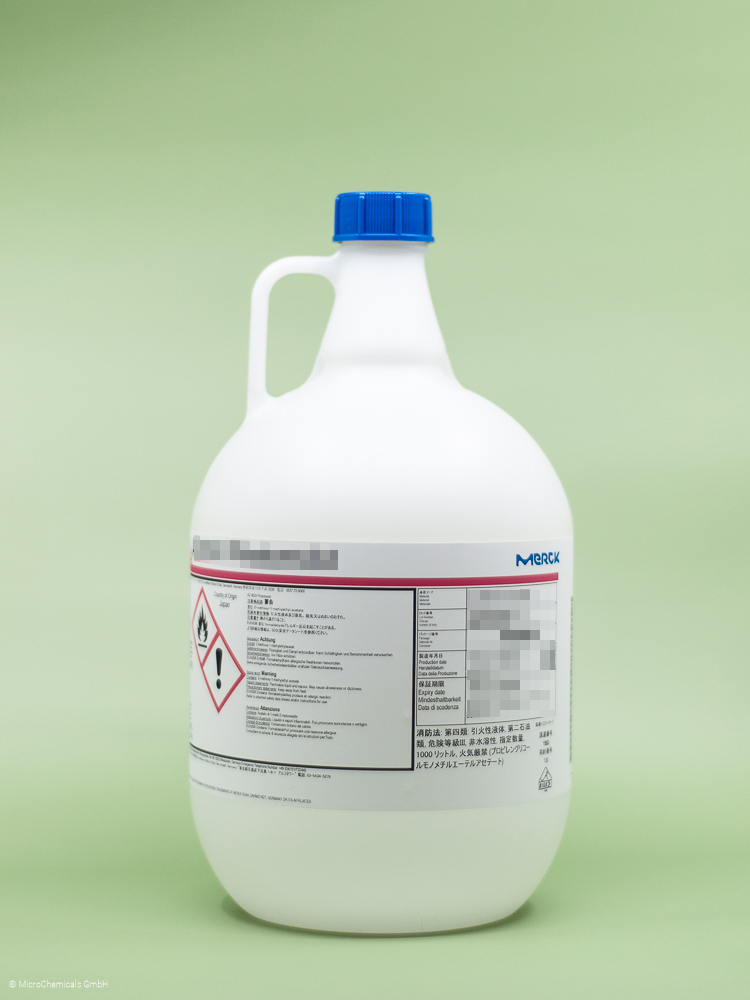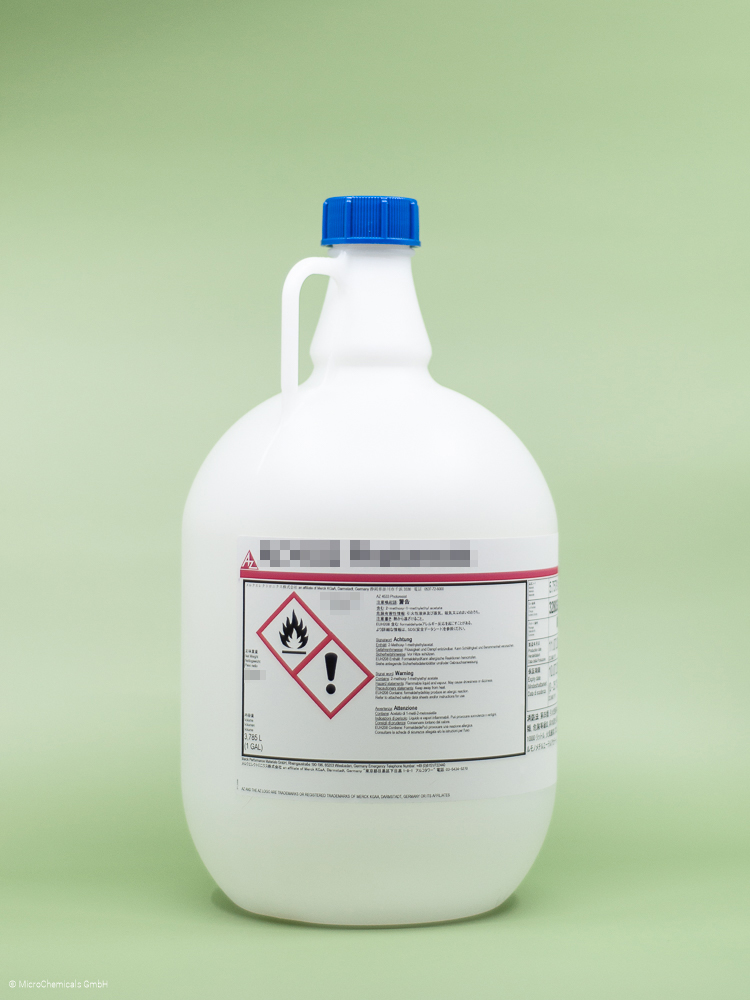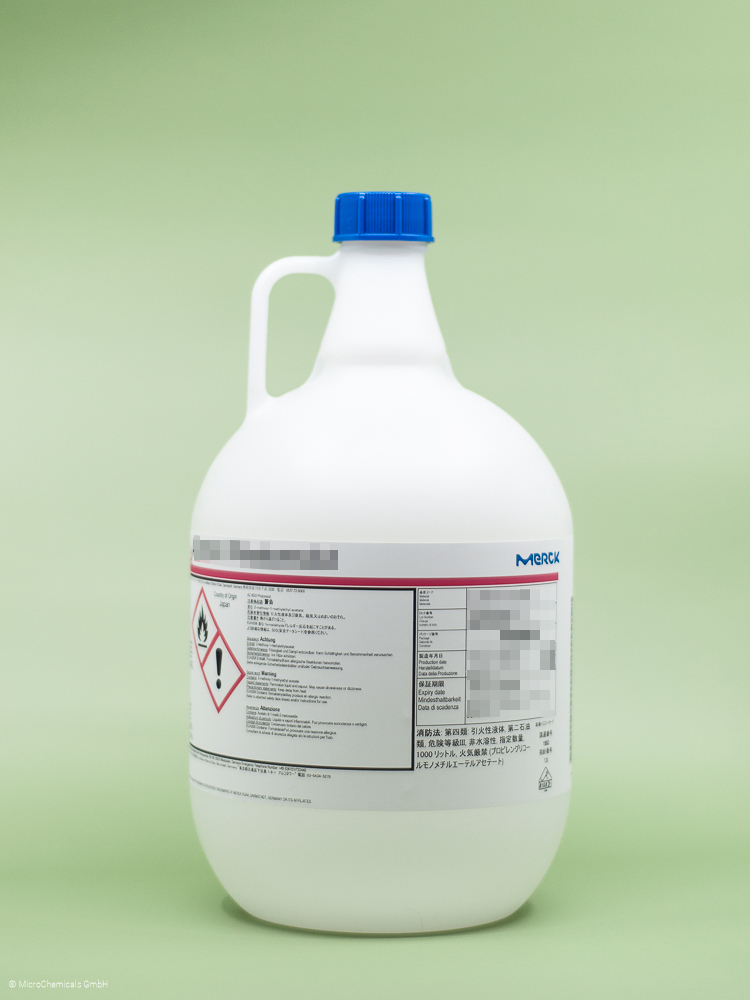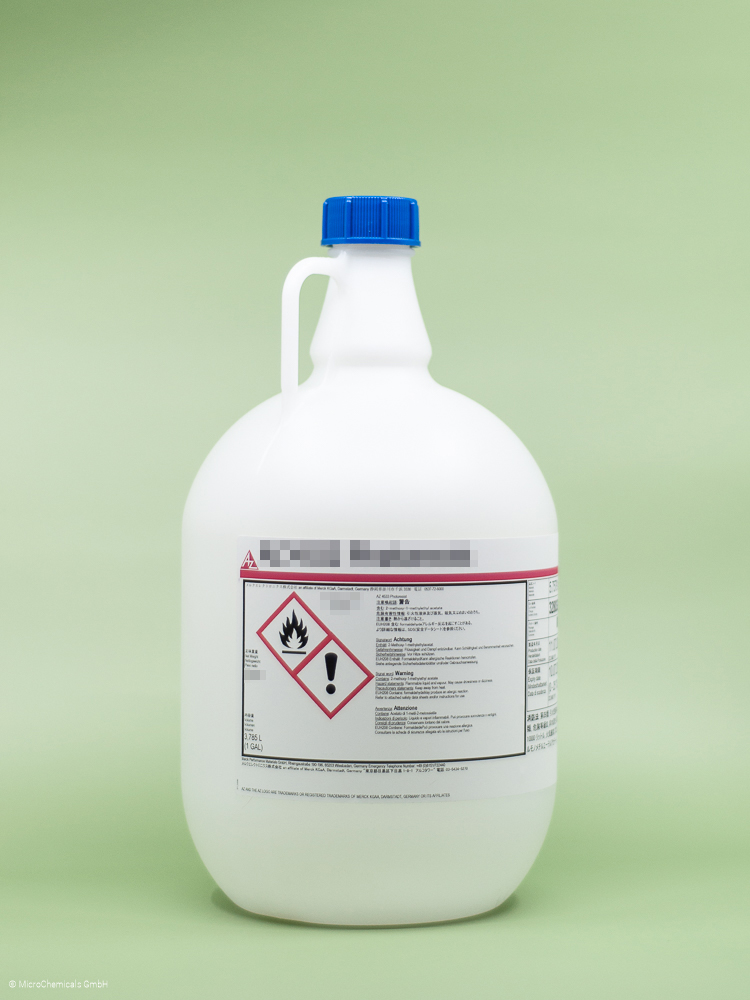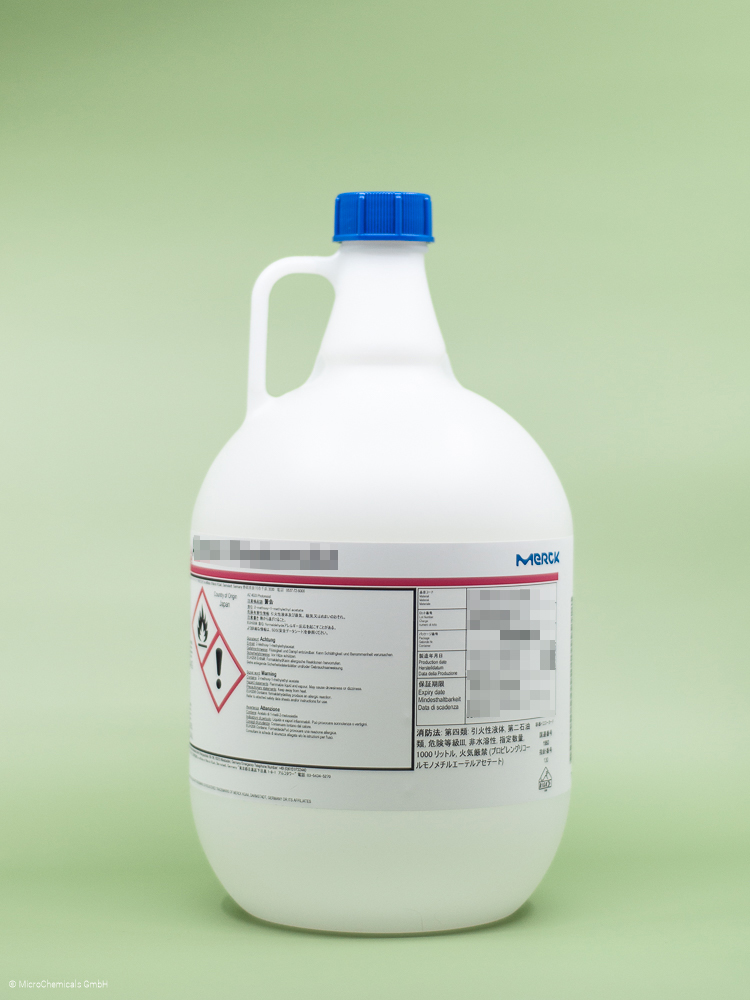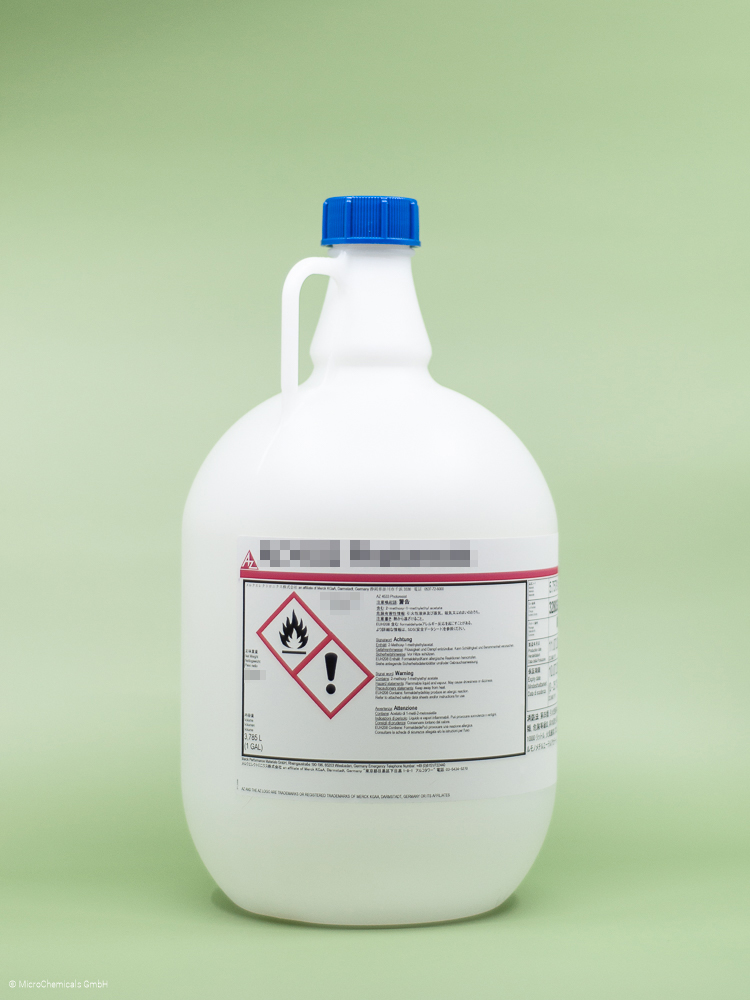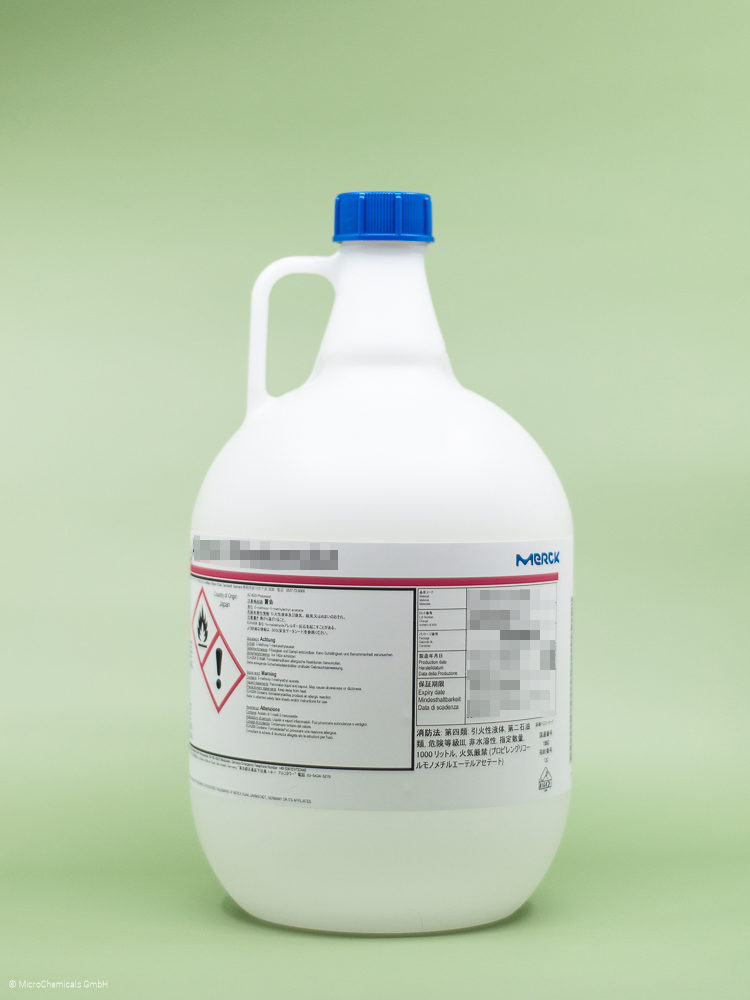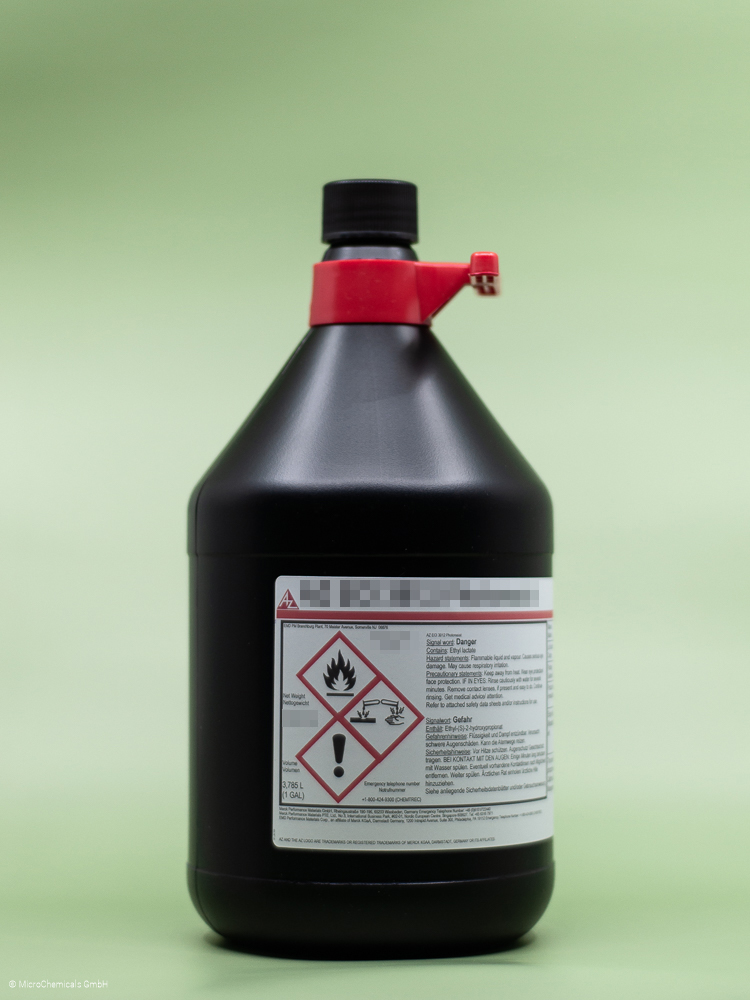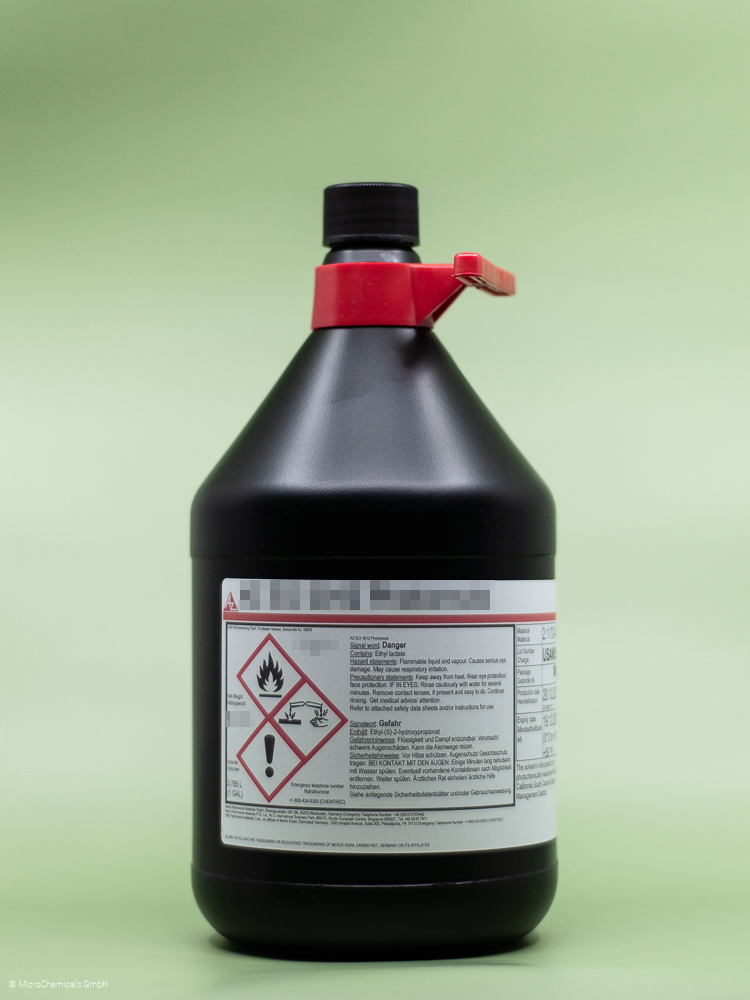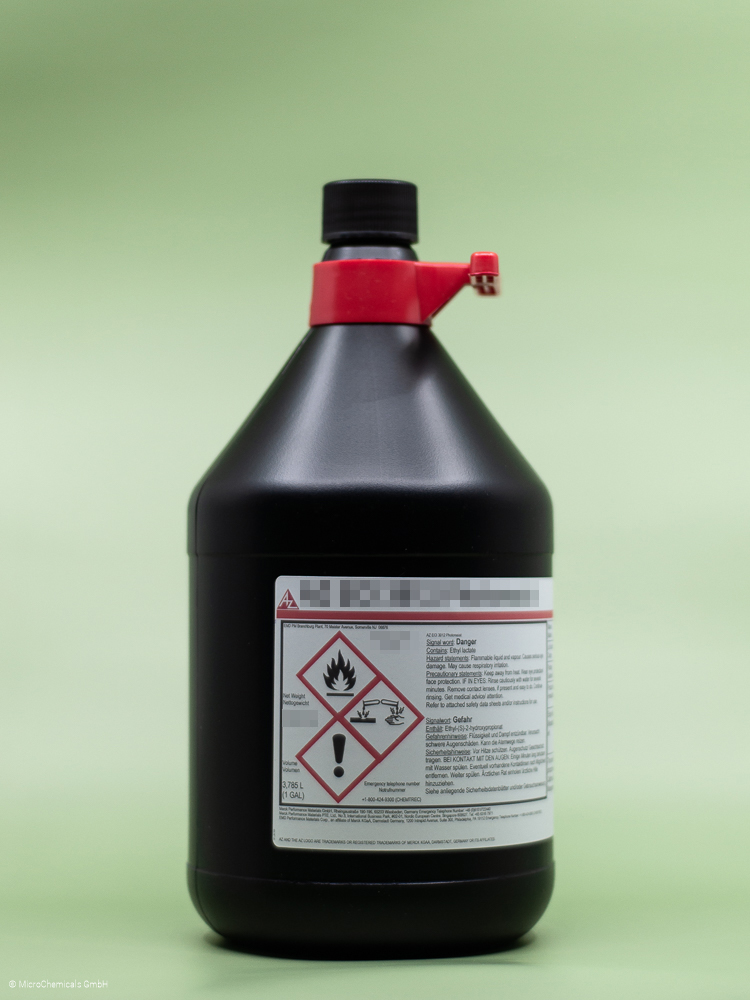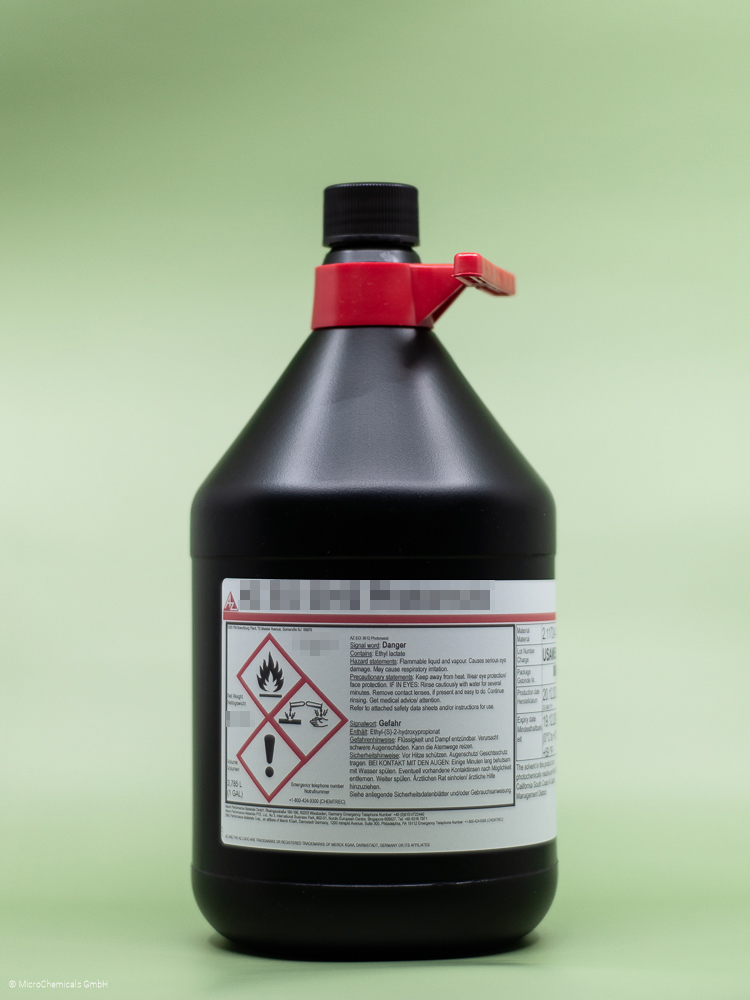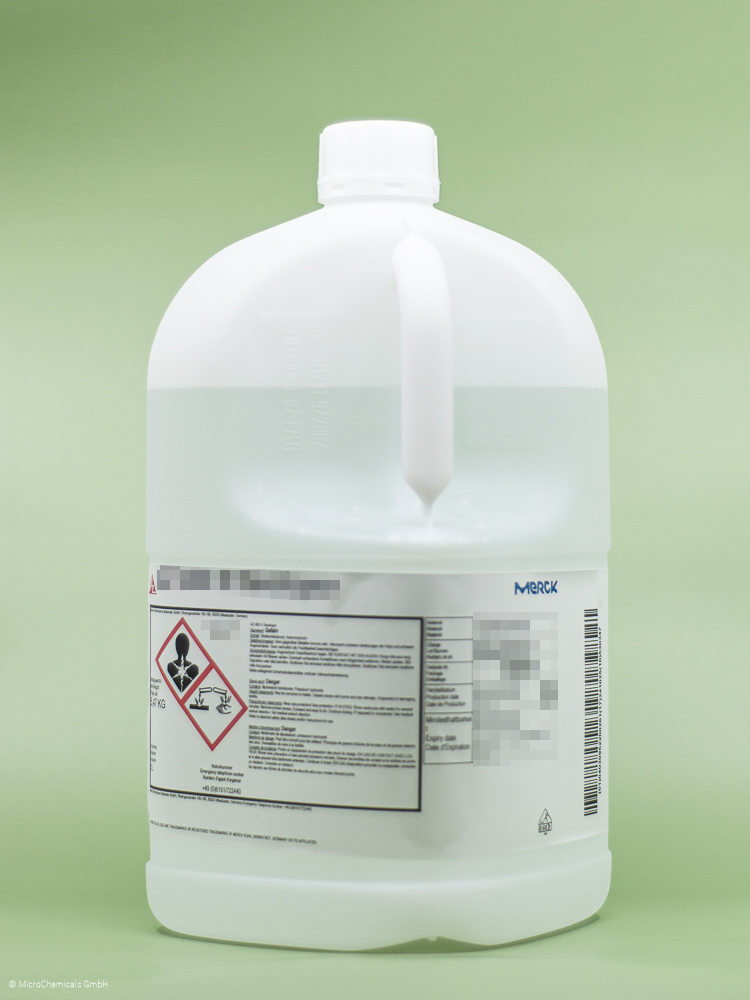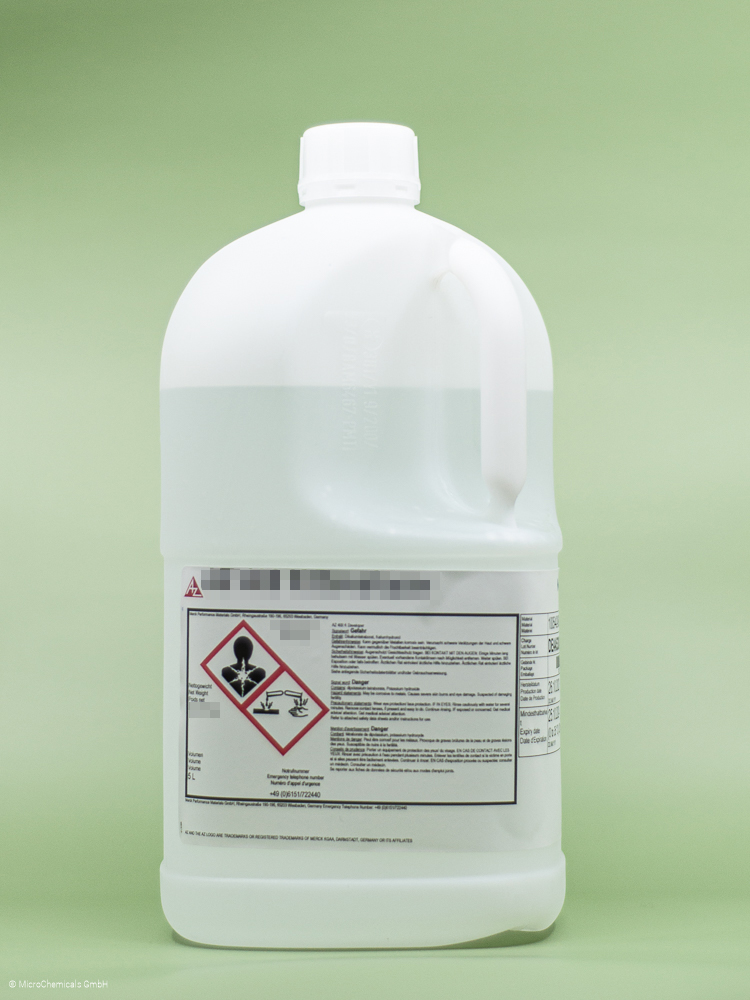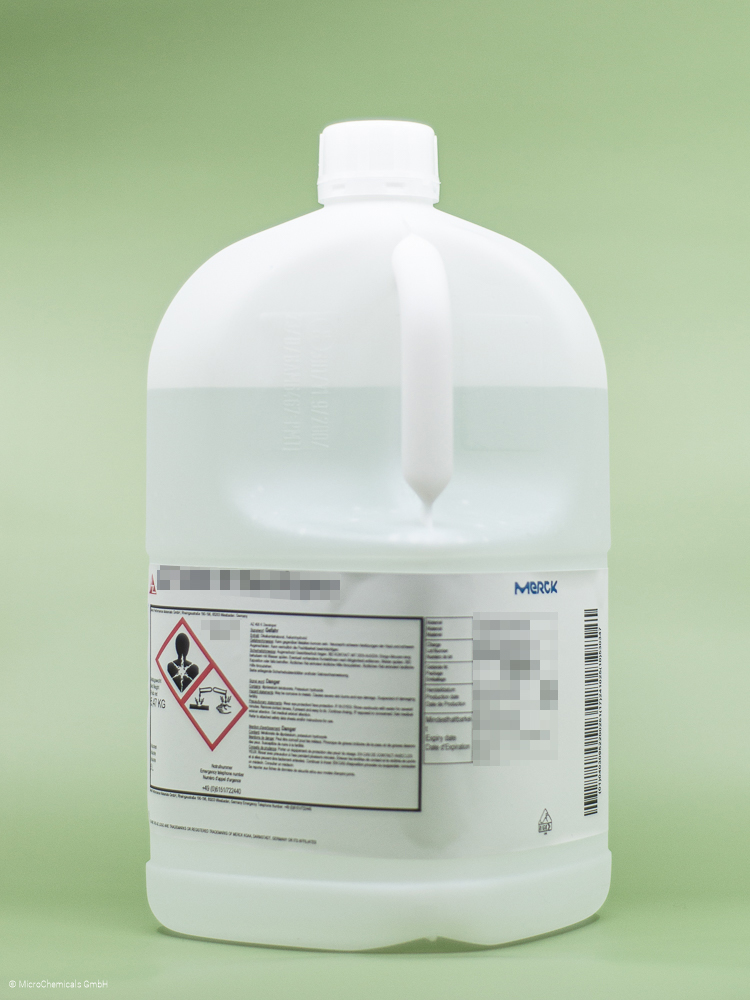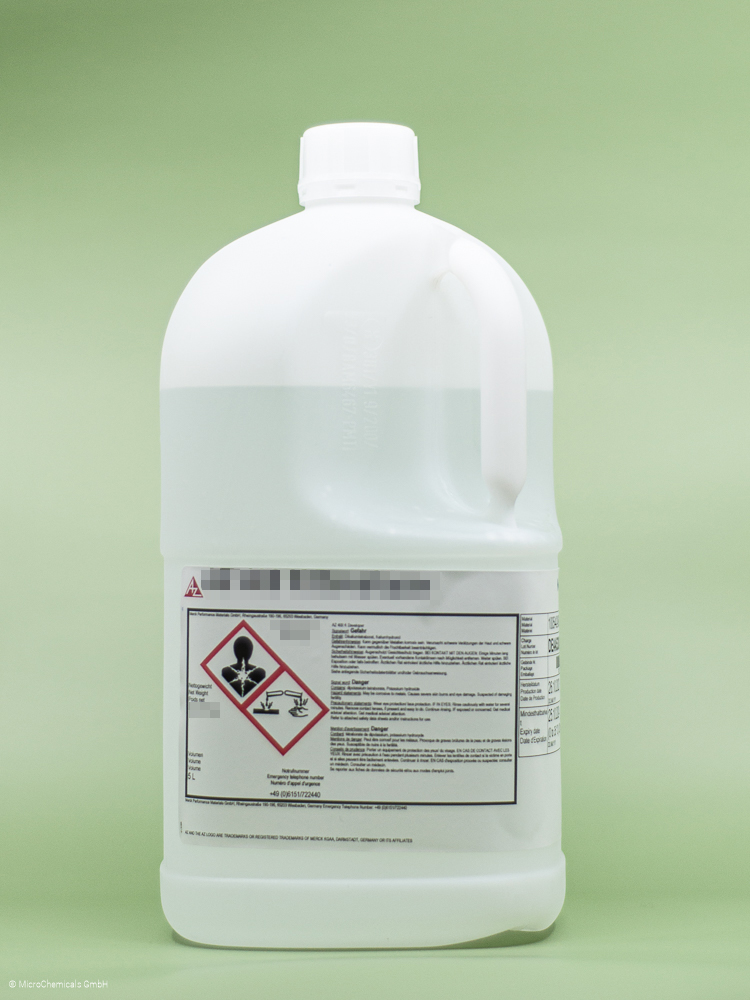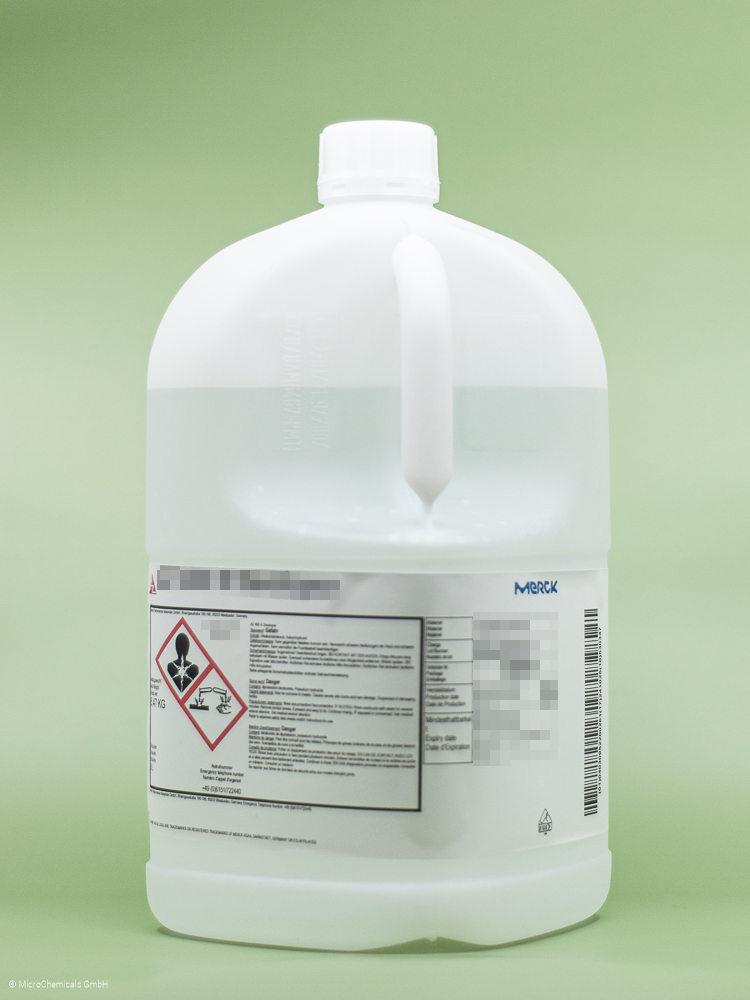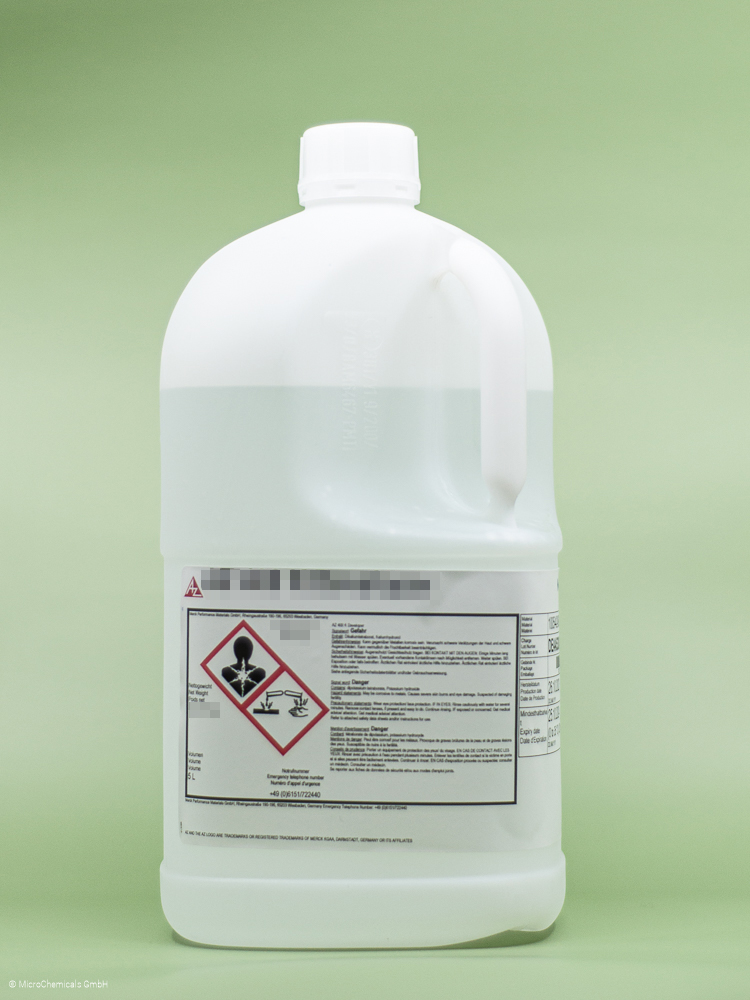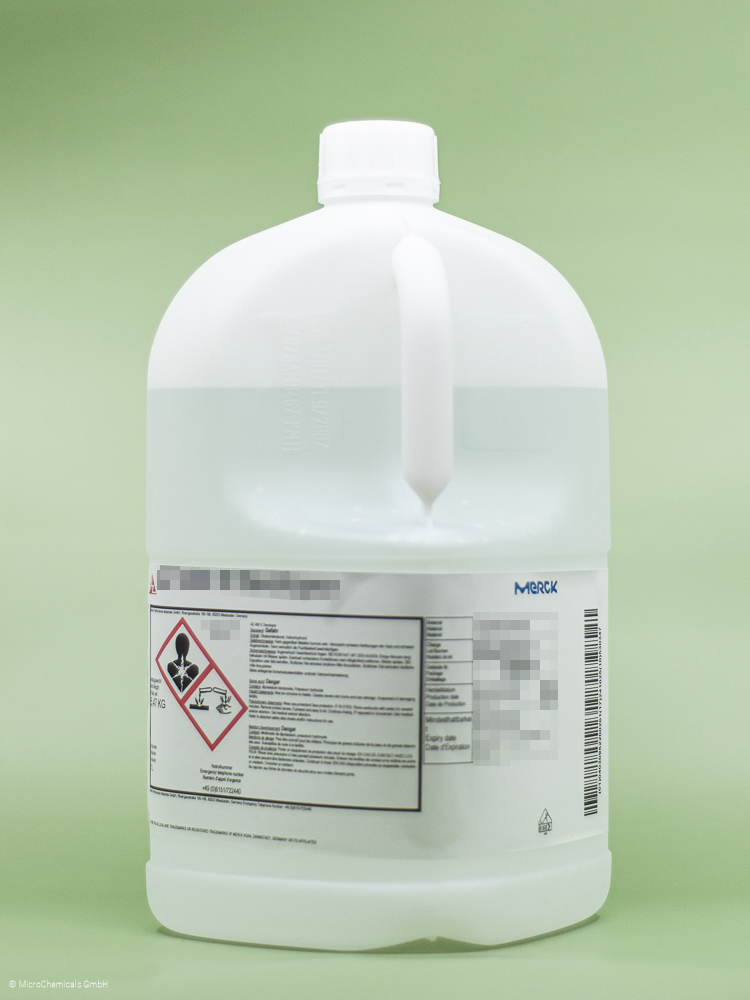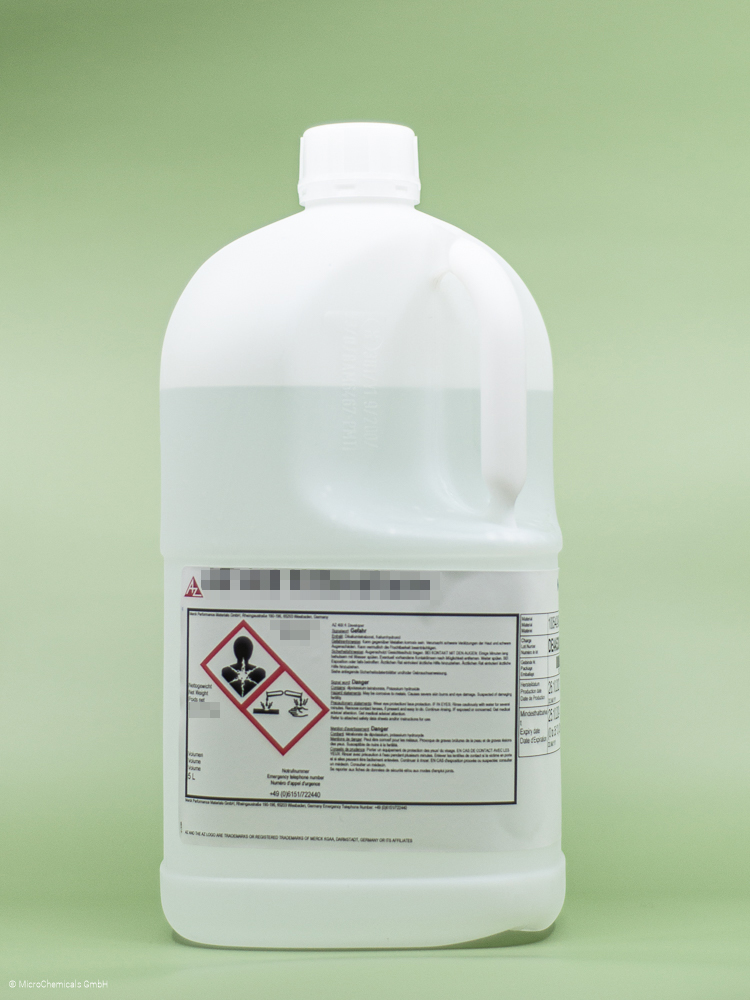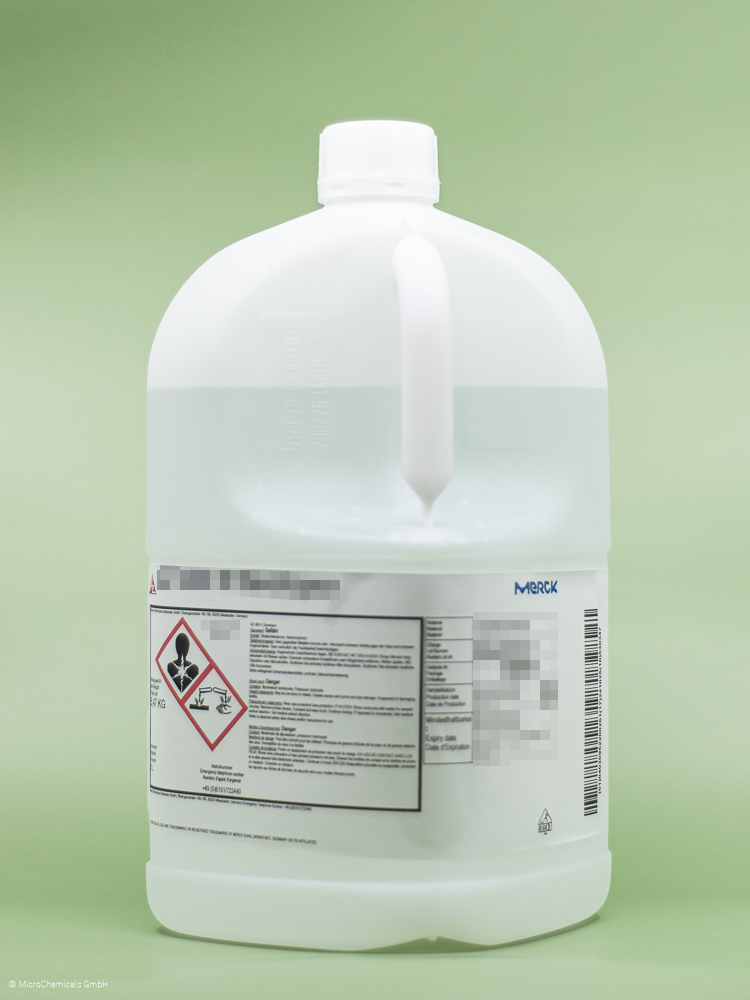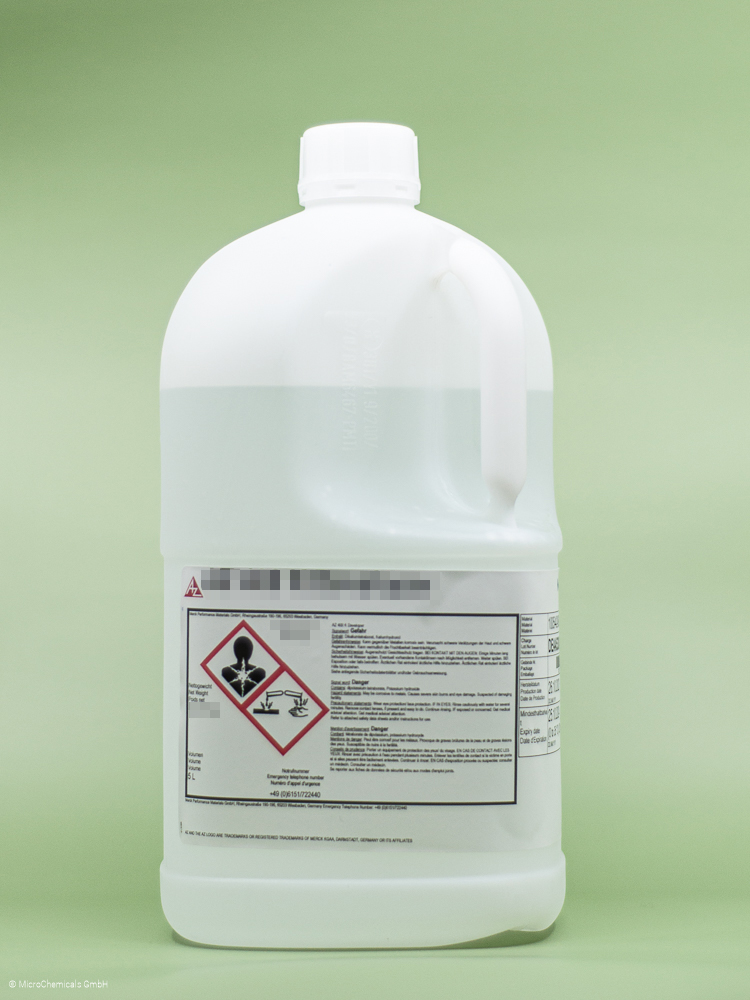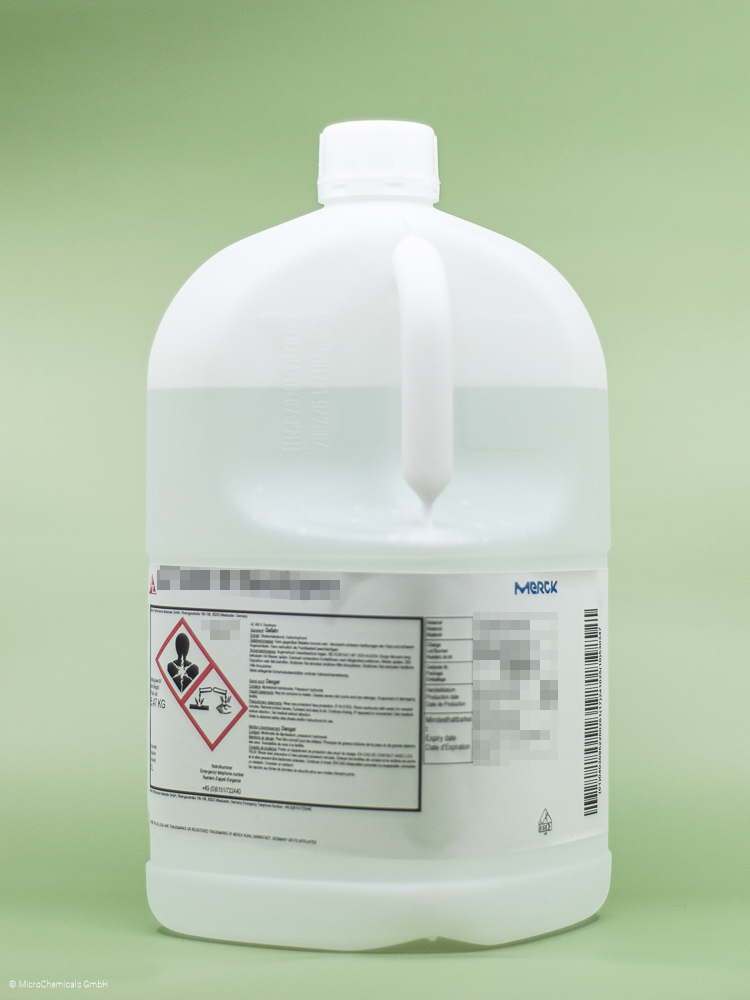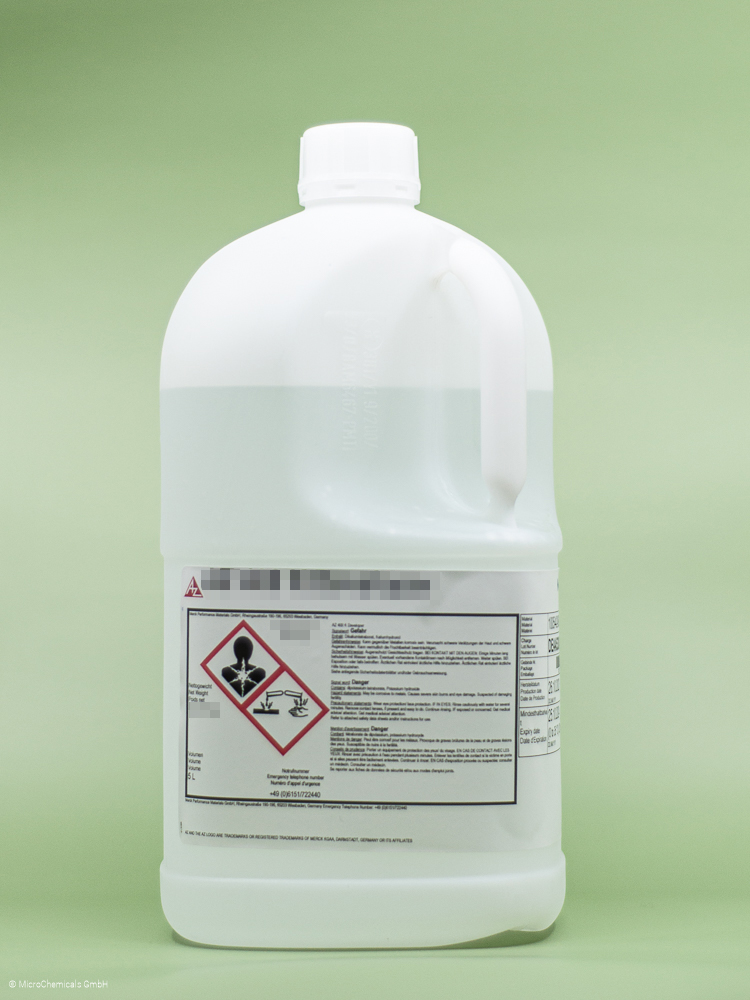SHOP
Filter
–
Acetic Acid 100 % - 2.50 l - VLSI
TESV1025
Acetic Acid
CH3COOH
General Information
Acetic Acid as surfactant and buffer is a commonly used additive for various etching mixtures.
We supply Acetic Acid (99 %) in VLSI-quality, which is the usual purity grades applied in semiconductor processing and micro-electronics.
Further Information
MSDS:
Safety Data Sheet Acetic Acid (VLSI) 100 % english
Sicherheitsdatenblatt Essigsäure (VLSI) 100 % german
Specs:
Specs Acetic Acid (VLSI) 100 %
Application Notes:
Wet Etching english
Nasschemisch Ätzen german
Acetone MC - 2.50 l - ULSI - EUD/EVE!
MACU1025
Manufacturer:
MicroChemicals GmbH
|
Bottle size:
2.50 l
|
Purity:
ULSI
Acetone
CH3COCH3
General Information
Acetone removes organic impurities from substrates and is well suited for greasy/oily contaminations. However, its large vapour pressure causes rapid drying together with a resorption of the contaminants on the substrate. Therefore an immediately subse¬quent rinsing step is recommended with a higher boiling solvent such as isopropanol.
Acetone is not well-suited as lift-off medium due to the high fire danger when heated and the trend of particles to be lifted to resorb onto the substrate.
Product Properties
Density: 0.79 g/cm^3
Melting point: 95°C
Boiling point: 56°C
Flash point: < -18°C
Vapour pressure @ 20°C: 244 hPa
Acetone Molecule
Further Information
MSDS:
Safety Data Sheet Acetone english (TECHNIC France)
Sicherheitsdatenblatt Aceton german (TECHNIC France)
Safety Data Sheet Acetone english (MicroChemicals GmbH)
Sicherheitsdatenblatt Aceton german (MicroChemicals GmbH)
Specs:
Specs Acetone ULSI (TECHNIC France)
Specs Acetone VLSI (TECHNIC France)
Specs Acetone ULSI (MicroChemicals GmbH)
Application Notes:
Solvents english
Lösemittel german
Ammonium hydroxide solution 28-30% - 2.50 l - VLSI - EVE/EUD!
HAMV1025
Ammonia Solution
NH4OH
General Information
Mixed with H2O2, Ammonia is an ingredient of many etching mixtures for metals such as copper, silver or aluminum.
Our Ammonia solution (28 - 30%) is available in VLSI-quality, which is the usual purity grades applied in semiconductor processing and micro-electronics.
Data on selectivity and compatibility are manufacturer information and do not claim to be complete. Please contact us for further details.
Further Information
MSDS:
Safety Data Sheet Ammonium Hydroxide Solution (VLSI) 28-30% english
Specs:
Specs Ammonium Hydroxide Solution (VLSI) 28-30%
Application Notes:
Wet Etching english
Nasschemisches Ätzen german
Annual Calendar
€0.00*
Wandkalender
Calendar
70 x 100cm
We send our wall calendars to our customers every year. If you are interested in a 70 x 100cm annual calendar, please add it to your order or just fill in the form.
Au etch 200 - 5.00 l
nbtaue2005
Bottle size:
5.00 l
Au etch 200
Gold Etchant
General Information
Au etch 200 is a non-hazardous, cyanide-free, slightly alkaline etchant for Au. The etchant is used for the wet-chemical patterning of Au layers with selectivity to metals like Pt, Ni, Cr, Ti, Al. Common areas of use for semiconductor fabrication or micro system technology.
Product Properties
Low undercut (in the range of the layer thickness), minimum feature size < 1 µm
Selectivity to many materials, e.g. common metals used in electroplating industry
Available in different purity grades
Compatible to resist masking
Not hazardous substance and easy to handle
Selectivity
Au etch 200 is compatible/etches selective to following materials:
Resists: common Novolak as masking resist (e.g. AZ® Photoresist)
Metals: no attack on Pt, Ni, Cr, Ti, Al, Ta
Metals: attacked Au, Cu
Semiconductor materials: Si, SiO2, Si3N4
Data on selectivity and compatibility are manufacturer information and do not claim to be complete. Please contact us for further details.
Etching Rate
Under normal condition, the etching rate is around 40 nm/min (at 50°C). The mixed etching solution is stable over time and can be used multiple times depending on the requirements of application. It is recommended to dispose the solution at the latest, when the etching rate has changed by 20%.
Further Information
MSDS:
Safety Data Sheet Au etch 200 english
Sicherheitsdatenblatt Au etch 200 german
TDS:
Technical Data Sheet Au etch 200 english
Technical Data Sheet Au etch 200 german
Application Notes:
Wet Etching english
Nasschemisches Ätzen german
Wet Etching of Metals english
Nasschemisches Ätzen von Metallen german
Further Information about Processing
AX 100 - 5.00 l
nbtax1005
Bottle size:
5.00 l
AX 100
Activator
General Information
AX 100 is an acidic solution for activating and pretreating seed layers and metallic surfaces for electroplating, on which a direct metallization may cause problems regarding the adhesive strength. This applies e.g. for the electroplating of Au on Ni surfaces or direct electroplating on Ti or TiW layers.
AX 100 activates metallic surfaces before electroplating and allows a better adhesive strength of electroplated layers on metallic surfaces, which tend to oxidation.
Common fields of application are semiconductor fabrication and microsystem technology.
Product Properties
Low or none etch attack on metallic surfaces
Compatible to many materials, e.g. common metals used in electroplating industry
Compatible to resist masking
Not poisonous substance and easy to handle
Moderate operation temperature of about 40°C
Selectivity
AX 100 is compatible/etches selective to following materials:
Resists: common Novolak as masking resist (e.g. AZ® Photoresist)
Metals: no attack on Ni, Ti, TiW, Ta, Cu
Semiconductor materials: Si, SiO2, Si3N4
Data on selectivity and compatibility are manufacturer information and do not claim to be complete. Please contact us for further details.
Further Information
MSDS:
Safety Data Sheet AX 100 english
Sicherheitsdatenblatt AX 100 german
TDS:
Technical Data Sheet AX 100 english
Application Notes:
Further Information about Processing
AZ 100 Remover - 5.00 l
1000100
AZ® 100 Remover
Universal Photoresist Stripper
General Information
AZ®100 Remover is based on solvent and amine (alkaline). AZ®100 Remover is used for photoresist stripping with low attack to aluminium. Low hazard is achieved by the use of ethanol amine.
Low evaporation rate allows the use at elevated temperatures (up to 80°C), high efficiency (>3000 wafer per litre) helps saving costs. Where attack to aluminium is of no concern, it may even be diluted with water.
AZ®100 Remover is not compatible with AZ® nLof 2070 (AZ® nLof 2000 series) resists and other heavily cross linked resists.
Product Properties
Density (at 25°C): 0.955 kg/l
Color (Alpha): max. 20
Flashpoint (AP): 72°C
Normality (potentiometric): 3.1 mol/l
Boiling range: 159-194°C
Further Information
MSDS:
Safety Data Sheet AZ® 100 Remover english
Sicherheitsdatenblatt AZ® 100 Remover german
TDS:
Technical Data Sheet AZ® 100 Remover english
Application Notes:
Photoresist removal english
Fotolack entfernen german
AZ 10XT Photoresist (220cP) - 3.785 l
1A10XT220
AZ® 10XT (220CPS)
Thick photoresist for high resolution
General Information
AZ® 10XT is an i- and h-line (not g- line !) sensitive positive thick photoresist, as the successor to the AZ® 9260 and is largely identical in construction, but with a different surfactant. In contrast to the similarly named AZ® 12XT, the AZ® 10XT is not chemically amplified.
3.0 µm lines in 12 µm thick AZ® 10XT Ultratech 1500 Exposure, AZ® 400K Developer 1:4 (260s spray)
Product Features
AZ® 10XT not only has optimized resist adhesion to common substrate materials, but also the potential for very steep resist sidewalls and high aspect ratios. Accordingly, the AZ® 10XT is often used in electroplating, ion implantation or dry etching/RIE. AZ® 10XT achieves a resist film thickness of approx. 6 µm at a spin speed of 4000 rpm; with an appropriately adjusted spin profile, the resist film thickness range of approx. 4.5 - 20 µm can be covered. If thinner resist layers are desired, the AZ® 10XT can be diluted with PGMEA; alternatively, the thinner AZ® 4533 can also be used for many applications. From a resist film thickness of approximately 10 - 15 µm, processing the AZ® 10XT becomes increasingly time-consuming: the soft bake and subsequent development take longer, more and more time is needed for rehydration between soft bake and exposure, and the risk of nitrogen bubbles forming during exposure increases. For resist film thicknesses greater than 10 µm, it is recommended to consider using a chemically amplified thick resist such as AZ® 12 XT (5 - 20 µm resist film thickness) or AZ®IPS 6090 (> 20 µm resist film thickness), which have significantly shorter soft bake and development times for the corresponding resist thickness, do not need rehydration, require significantly lower exposure doses, and do not release nitrogen during exposure.
Developers
For development, we recommend either TMAH-based developers such as the ready-to-use AZ® 326 MIF or AZ® 726 MIF, or the KOH-based AZ® 400K 1:4 (typically 1: 4 diluted with water, for faster development also slightly stronger with 1:3.5 or 1:3). On alkaline-sensitive substrate materials such as aluminum, we recommend the aluminum-compatible, undiluted AZ® Developer.
Removers
If the resist structures have not been thermally cross-linked by plasma processes, ion implantation or high temperatures (> approx. 140 °C), all common removers such as AZ® 100 Remover, DMSO or many other organic solvents (e.g. Acetone rinsed with Isopropanol) are suitable for removing the resist layer. For cross-linked resist structures, high-performance strippers such as the NMP-free TechniStrip P1316 or AZ® 920 Remover are recommended, and in the case of alkaline-sensitive substrate materials (such as aluminum), the TechniStrip MLO 07.
Thinning / Edge Wall Removal
If the resist is to be diluted for spin coating, PGMEA = AZ® EBR Solvent is the recommended solvent. PGMEA is the solvent for AZ® 10 XT anyway and is also recommended for edge wall removal if necessary.
Further Information
Our safety data sheets and some of our technical data sheets are password-protected.
You will receive the access data after completing the form.
The access data for the data sheets are not your login data from our shop!
MSDS:
Safety Data Sheet AZ® 10XT (220cps) english
Safety Data Sheet AZ® 10XT (220cps) german
TDS:
Technical Data Sheet AZ® 10XT (220cps) english
Application Notes:
Further Information about Photoresist Processing
AZ 10XT Photoresist (520cP) - 3.785 l
1A010XT00
Bottle size:
3.785 l
AZ® 10XT (520CPS)
Thick photoresist for high resolution
General Information
AZ® 10XT is an i- and h-line (not g- line !) sensitive positive thick photoresist, as the successor to the AZ® 9260 and is largely identical in construction, but with a different surfactant. In contrast to the similarly named AZ® 12XT, the AZ® 10XT is not chemically amplified.
3.0 µm lines in 12 µm thick AZ® 10XT Ultratech 1500 Exposure, AZ® 400K Developer 1:4 (260s spray)
Product Features
AZ® 10XT not only has optimized resist adhesion to common substrate materials, but also the potential for very steep resist sidewalls and high aspect ratios. Accordingly, the AZ® 10XT is often used in electroplating, ion implantation or dry etching/RIE. AZ® 10XT achieves a resist film thickness of approx. 6 µm at a spin speed of 4000 rpm; with an appropriately adjusted spin profile, the resist film thickness range of approx. 4.5 - 20 µm can be covered. If thinner resist layers are desired, the AZ® 10XT can be diluted with PGMEA; alternatively, the thinner AZ® 4533 can also be used for many applications. From a resist film thickness of approximately 10 - 15 µm, processing the AZ® 10XT becomes increasingly time-consuming: the soft bake and subsequent development take longer, more and more time is needed for rehydration between soft bake and exposure, and the risk of nitrogen bubbles forming during exposure increases. For resist film thicknesses greater than 10 µm, it is recommended to consider using a chemically amplified thick resist such as AZ® 12 XT (5 - 20 µm resist film thickness) or AZ®IPS 6090 (> 20 µm resist film thickness), which have significantly shorter soft bake and development times for the corresponding resist thickness, do not need rehydration, require significantly lower exposure doses, and do not release nitrogen during exposure.
Developers
For development, we recommend either TMAH-based developers such as the ready-to-use AZ® 326 MIF or AZ® 726 MIF, or the KOH-based AZ® 400K 1:4 (typically 1: 4 diluted with water, for faster development also slightly stronger with 1:3.5 or 1:3). On alkaline-sensitive substrate materials such as aluminum, we recommend the aluminum-compatible, undiluted AZ® Developer.
Removers
If the resist structures have not been thermally cross-linked by plasma processes, ion implantation or high temperatures (> approx. 140 °C), all common removers such as AZ® 100 Remover, DMSO or many other organic solvents (e.g. Acetone rinsed with Isopropanol) are suitable for removing the resist layer. For cross-linked resist structures, high-performance strippers such as the NMP-free TechniStrip P1316 or AZ® 920 Remover are recommended, and in the case of alkaline-sensitive substrate materials (such as aluminum), the TechniStrip MLO 07.
Thinning / Edge Wall Removal
If the resist is to be diluted for spin coating, PGMEA = AZ® EBR Solvent is the recommended solvent. PGMEA is the solvent for AZ® 10 XT anyway and is also recommended for edge wall removal if necessary.
Further Information
Our safety data sheets and some of our technical data sheets are password-protected.
You will receive the access data after completing the form.
The access data for the data sheets are not your login data from our shop!
MSDS:
Safety Data Sheet AZ® 10XT (520cps) english
Safety Data Sheet AZ® 10XT (520cps) german
TDS:
Technical Data Sheet AZ® 10XT (520cps) english
Anwendungshinweis:
Further Information about Photoresist Processing
AZ 125nXT-10B Photoresist - 3.785 l
1125nXT10B
Bottle size:
3.785 l
AZ® 125nXT-10B
Ultra-Thick Negative Resist for Plating
General Information
The AZ® 125nXT-10B is an i-line sensitive, negative ultra-thick resist with steep resist sidewalls and high aspect ratio.
20 µm lines at 60 µm resist film thickness.
15 µm holes at 60 µm resist film thickness.
80 µm plated CuNi image.
Product Features
The ultra-thick negative resist AZ® 125nXT-10B covers a resist film thickness range of 20 - 50 µm and can be built up and processed to 100 µm and much more with adapted spin profiles. AZ® 125nXT-10B is only i-line sensitive and, as a special feature (for negative resists), does not require a post exposure bake after exposure for cross-linking, i.e. the AZ® 125nXT-10B photopolymerizes. Due to its low absorption, even very thick resist layers can be easily exposed and steep resist sidewalls can be achieved. This and its very good adhesion to all common substrate materials make this resist suitable for the galvanic molding of thick to very thick layers as well as DRIE. With low exposure doses or very thick resist layers - related to the respective resist film thickness - the resist profile becomes slightly negative, since the resist areas close to the substrate experience less cross-linking. If the electroplating process shows that these weakly cross-linked areas of the resist are attacked, but a higher structuring exposure dose is not an option, flood exposure (without a photomask) after development with very high doses can cross-link the resist sidewalls even near the substrate, which, however, makes it more difficult to strip the resist later. Even after such flood exposure, no further post exposure back is necessary. AZ® 125nXT-10B can generally be processed with resist films of less than 20 µm thick, but processing becomes problematic below 10 µm thickness: Since the additive responsible for cross-linking escapes from the resist surface during softbaking, only a few micrometers of the exposed resist surface are removed during development, which accounts for a correspondingly large proportion of the total thickness in the case of thin resist films.
Developers
AZ® 326 MIF (immersion development), AZ® 726 MIF (puddle development) or AZ® 2026 MIF (which has an additive that promotes residue-free development, especially with cross-linking resists) are recommended for developing the AZ® 125nXT-10B. KOH- or NaOH-based developers such as AZ® 400K or AZ® 351B are generally not suitable for the AZ® 125nXT-10B. If TMAH-based developers cannot be used, a KOH-based developer in higher concentration than usual can be considered.
Removers
AZ® 125nXT-10B can be removed wet-chemically using conventional strippers, but stripping very thick cross-linked resist structures can be quite a challenge. If organic solvents are preferred for this, (hot) DMSO is recommended, which does not dissolve cross-linked resists, but can detach them from the substrate after a certain exposure time. This process can be accelerated by reducing the degree of cross-linking of the resist near the substrate by using a lower exposure dose. Alternatively, high-performance strippers such as the NMP-free TechniStrip P1316 are recommended, or in the case of alkaline-sensitive substrate materials (such as aluminum), the TechniStrip MLO 07.
Thinning/ Edge Wall Removal
If the resist is to be diluted for spin coating, PGMEA = AZ® EBR Solvent is an option. PGMEA is the solvent for AZ® 125nXT-10B anyway and is also recommended for edge wall removal if necessary.
Further Information
Our safety data sheets and some of our technical data sheets are password-protected.
You will receive the access data after completing the form.
The access data for the data sheets are not your login data from our shop!
MSDS:
Safety Data Sheet AZ® 125nXT-10B english
Safety Data Sheet AZ® 125nXT-10B german
TDS:
Technical Data Sheet AZ® 125nXT-10B english
Application Notes:
Further Information about Photoresist Processing
AZ 12XT-20PL-10 Photoresist - 3.785 l
1A012XT1000
Bottle size:
3.785 l
AZ® 12XT-20PL-10
Chemically Amplified Positive Tone Photoresists
General Information
AZ® 12XT is a chemically amplified, i-line sensitive thick photoresist for high aspect ratios and with an increased thermal softening point.
AZ® 12XT - 2.4mm lines at 10mm film thickness
Product Features
AZ® 12XT covers a resist film thickness range of approx. 5 - 20 µm. As a chemically amplified resist, the AZ® 12XT does not require rehydration between softbake and exposure, requires significantly lower exposure doses compared to non-chemically amplified resists of comparable thickness, does not release nitrogen during exposure (no bubble formation in the resist film during exposure), and has very high development rates for a thick resist. These properties help to make the entire process significantly faster and less prone to problems than with non-chemically amplified thick resists. Its good adhesion to all common substrate materials and its potential for steep resist sidewalls make it suitable for galvanic molding, and its high thermal softening point (approx. 130 °C) also recommends it for dry etching or DRIE. Basically, the AZ® 12XT is only sensitive to i-line, but with correspondingly high exposure doses and resist film thicknesses, the h-line (405 nm) can also be used. If resist film thicknesses of less than approx. 5 µm are required, the AZ® 12XT can easily be diluted with PGMEA = AZ® EBR Solvent. For resist film thicknesses greater than 15 µm, the chemically amplified AZ® IPS 6090 should be considered.
Developers
TMAH-based developers such as the ready-to-use AZ® 326 MIF or AZ® 726 MIF are recommended for developing this chemically amplified photoresist. KOH- or NaOH-based developers such as the AZ® 400 K or AZ® 351B are less suitable for the AZ® 12 XT.
Removers
If the resist structures have not been thermally cross-linked by plasma processes, ion implantation or high temperatures (> approx. 140 °C), all common removers such as AZ® 100 Remover, DMSO or many other organic solvents (e.g. acetone rinsed with isopropanol) are suitable for removing the resist layer. For cross-linked resist structures, high-performance strippers such as the NMP-free TechniStrip P1316 or AZ® 920 Remover are recommended, and in the case of alkaline-sensitive substrate materials (such as aluminum), the TechniStrip MLO 07.
Thinning/ Edge Bead Removal
If the resist is to be diluted for spin coating, PGMEA = AZ® EBR Solvent is an option. PGMEA is the solvent for AZ® 12 XT anyway and is also recommended for edge wall removal if necessary.
Further Information
Our safety data sheets and some of our technical data sheets are password-protected.
You will receive the access data after completing the form.
The access data for the data sheets are not your login data from our shop!
MSDS:
Safety Data Sheet AZ® 12XT 20PL-10 english
Safety Data Sheet AZ® 12XT 20PL-10 german
TDS:
Technical Data Sheet AZ® 12XT 20PL-10 english
Application Notes:
Further Information about Photoresist Processing
AZ 12XT-20PL-15 Photoresist - 3.785 l
1A012XT1500
AZ® 12XT-20PL-15
Chemically Amplified Positive Tone Photoresists
General Information
AZ® 12XT is a chemically amplified, i-line sensitive thick photoresist for high aspect ratios and with an increased thermal softening point.
AZ® 12XT - 2.4mm lines at 10mm film thickness
Product Features
AZ® 12XT covers a resist film thickness range of approx. 5 - 20 µm. As a chemically amplified resist, the AZ® 12XT does not require rehydration between softbake and exposure, requires significantly lower exposure doses compared to non-chemically amplified resists of comparable thickness, does not release nitrogen during exposure (no bubble formation in the resist film during exposure), and has very high development rates for a thick resist. These properties help to make the entire process significantly faster and less prone to problems than with non-chemically amplified thick resists. Its good adhesion to all common substrate materials and its potential for steep resist sidewalls make it suitable for galvanic molding, and its high thermal softening point (approx. 130 °C) also recommends it for dry etching or DRIE. Basically, the AZ® 12XT is only sensitive to i-line, but with correspondingly high exposure doses and resist film thicknesses, the h-line (405 nm) can also be used. If resist film thicknesses of less than approx. 5 µm are required, the AZ® 12XT can easily be diluted with PGMEA = AZ® EBR Solvent. For resist film thicknesses greater than 15 µm, the chemically amplified AZ® IPS 6090 should be considered.
Developers
TMAH-based developers such as the ready-to-use AZ® 326 MIF or AZ® 726 MIF are recommended for developing this chemically amplified photoresist. KOH- or NaOH-based developers such as the AZ® 400 K or AZ® 351B are less suitable for the AZ® 12 XT.
Removers
If the resist structures have not been thermally cross-linked by plasma processes, ion implantation or high temperatures (> approx. 140 °C), all common removers such as AZ® 100 Remover, DMSO or many other organic solvents (e.g. acetone rinsed with isopropanol) are suitable for removing the resist layer. For cross-linked resist structures, high-performance strippers such as the NMP-free TechniStrip P1316 or AZ® 920 Remover are recommended, and in the case of alkaline-sensitive substrate materials (such as aluminum), the TechniStrip MLO 07.
Thinning/ Edge Wall Removal
If the resist is to be diluted for spin coating, PGMEA = AZ® EBR Solvent is an option. PGMEA is the solvent for AZ® 12 XT anyway and is also recommended for edge wall removal if necessary.
Further Information
Our safety data sheets and some of our technical data sheets are password-protected.
You will receive the access data after completing the form.
The access data for the data sheets are not your login data from our shop!
MSDS:
Safety Data Sheet AZ® 12XT 20PL-15 english
Safety Data Sheet AZ® 12XT 20PL-15 german
TDS:
Technical Data Sheet AZ® 12XT 20PL-15 english
Application Notes:
Further Information about Photoresist Processing
AZ 1505 Photoresist - 3.785 l
1A001505
Bottle size:
3.785 l
AZ® 1505
Positive Thin Resists for Wet Etching
General Information
The AZ® 1505 Photoresist belongs to the AZ® 1500 Photoresist Series of positive thin resists (g-, h- and i-line sensitive) with optimized adhesion to all common substrate materials, the main application of which is as a resist mask for wet etching.
Product Properties
AZ® 1500 Resist Family is not optimized for very steep resist sidewalls nor for high stability against thermal softening (softening temperature approx. 100 °C), but for improved adhesion to all common substrate materials. The high photoinitiator concentration of the AZ® 1500 Photoresist Series compared to thick resists allows for very fast development.
AZ® 1505 Photoresist is the thinnest member of the AZ® 1500 Photoresist Series with a resist film thickness of approx. 500 nm at 4000 rpm. This resist is often used for chrome etching in photomask production, but is also suitable as an etching mask for other materials. AZ® 1505 allows a resolution in the submicrometer range under optimized process parameters. If such a high resolution is not required, a slightly thicker resist (for example AZ® 1514 H Photoresist or AZ® 1518 Photoresist) can be useful, which reduces the risk of pinholes in the resist film caused by particles on the substrate and the corresponding etching defects. Further dilution of the AZ® 1505 is not recommended, as heavily diluted, photoinitiator-rich resists tend to quickly form particles. If the resist does have to be diluted, the corresponding batches should be used up quickly and attention should be paid to possible particle formation.
Developers
For development, we recommend either TMAH-based developers such as AZ® 326 MIF or AZ® 726 MIF, the NaOH-based AZ® 351B, and if the requirements for selectivity are not too high, the KOH-based AZ® 400K. With AZ® 351Bor AZ® 400K, it may be advisable to work with a higher diluted developer (for example 1:5 to 1:6) instead of the usual 1:4 dilution to achieve very fine resist structures or better controllable development times. On alkaline-sensitive substrate materials such as aluminum, we recommend the aluminum-compatible AZ® Developer in a 1:1 dilution.
Removers
If the resist structures have not been thermally cross-linked by plasma processes, ion implantation or high temperatures (> approx. 140°C), all common removers such as AZ® 100 Remover, DMSO or many other organic solvents (e.g. acetone rinsed with isopropyl alcohol) are suitable for removing the resist layer. For cross-linked resist structures, high-performance strippers such as the NMP-free TechniStrip P1316 or AZ® 920 Remover are recommended, and in the case of alkaline-sensitive substrate materials (such as aluminum), the TechniStrip MLO 07.
Thinning/ Edge Bead Removal
Even if, as described above, further dilution of AZ® 1505 Photoresist is not recommended due to the accelerated particle formation, PGMEA = AZ® EBR Solvent is the recommended solvent. PGMEA is the solvent for AZ® 1505 anyway and is also recommended for edge wall removal if necessary.
Further Information
Our safety data sheets and some of our technical data sheets are password-protected.
You will receive the access data after completing the form.
The access data for the data sheets are not your login data from our shop!
MSDS:
Safety Data Sheet AZ® 1505 Photoresist english
Safety Data Sheet AZ® 1505 Photoresist german
TDS:
Technical Data Sheet AZ® 1505 Photoresist english
Application Notes:
Further Information about Photoresist Processing
AZ 1512 HS Photoresist - 3.785 l
1A001512
Bottle size:
3.785 l
AZ® 1512 HS
Positive Thin Resists for Wet Etching
General Information
The AZ® 1512 HS Photoresist belongs to the AZ® 1500 Photoresist Series of positive thin resists (g-, h- and i-line sensitive) with optimized adhesion to all common substrate materials, the main application of which is as a resist mask for wet etching.
Product Properties
AZ® 1500 Resist Family is not optimized for very steep resist sidewalls nor for high stability against thermal softening (softening temperature approx. 100°C), but for improved adhesion to all common substrate materials. The high photoinitiator concentration of the AZ® 1500 Photoresist Series compared to thick resists allows for very fast development.
AZ® 1512 HS Photoresist achieves a resist film thickness of approx. 1.3 µm at 4000 rpm and is often used for chrome etching in photomask production, but is also suitable as an etching mask for other materials. AZ® 1512 HS allows a resolution in the submicrometer range under optimized process parameters. If such a high resolution is not required, a slightly thicker resist (for example AZ® 1518 Photoresist) can be useful, which reduces the risk of pinholes in the resist layer caused by particles on the substrate and the corresponding etching defects. AZ® 1512 HS Photoresist has the highest photoinitiator concentration within the AZ® 1500 Photoresist Series, is correspondingly high in contrast, and shows a particularly high development rate. Diluting the AZ® 1512 HS is not advisable, as diluted resists that are very rich in photoinitiators tend to quickly form particles. If the resist still needs to be diluted, the corresponding amounts should be used up quickly and attention should be paid to possible particle formation.
Developers
For development, we recommend either TMAH-based developers such as AZ® 326 MIF or AZ® 726 MIF, the NaOH-based AZ® 351B (typically 1:4 diluted with water), and if the selectivity requirements are not too high, the KOH-based AZ® 400K (also typically 1:4 diluted with water). For very fine resist structures, a slightly higher dilution of the developer can be helpful. On alkaline-sensitive substrate materials such as aluminum, we recommend the aluminum-compatible AZ® Developer in a 2:1 to 1:1 dilution (developer : water).
Removers
If the resist structures have not been thermally cross-linked by plasma processes, ion implantation or high temperatures (> approx. 140°C), all common removers such as AZ® 100 Remover, DMSO or many other organic solvents (e.g. acetone rinsed with isopropyl alcohol) are suitable for removing the resist layer. For cross-linked resist structures, high-performance strippers such as the NMP-free TechniStrip P1316 or AZ® 920 Remover are recommended, and in the case of alkaline-sensitive substrate materials (such as aluminum), the TechniStrip MLO 07.
Thinning/ Edge Bead Removal
Even if, as described above, further dilution of AZ® 1515 HS Photoresistis not recommended due to the accelerated particle formation, PGMEA = AZ® EBR Solvent is the recommended solvent. PGMEA is the solvent for AZ® 1512 HS anyway and is also recommended for edge wall removal if necessary.
Further Information
Our safety data sheets and some of our technical data sheets are password-protected.
You will receive the access data after completing the form.
The access data for the data sheets are not your login data from our shop!
MSDS:
Safety Data Sheet AZ® 1512 HS Photoresist english
Safety Data Sheet AZ® 1512 HS Photoresist german
TDS:
Technical Data Sheet AZ® 1512 HS Photoresist english
Application Notes:
Further Information about Photoresist Processing
AZ 1514 H Photoresist - 3.785 l
1A001514
Bottle size:
3.785 l
AZ® 1514 H
Positive Thin Resist for Wet Etching
General Information
The AZ® 1514 H Photoresist belongs to the AZ® 1500 Photoresist Series of positive thin resists (g-, h- and i-line sensitive) with optimized adhesion to all common substrate materials, the main application of which is as a resist mask for wet etching.
Product Properties
AZ® 1500 Resist Family is not optimized for very steep resist sidewalls nor for high stability against thermal softening (softening temperature approx. 100°C), but for improved adhesion to all common substrate materials. The high photoinitiator concentration of the AZ® 1500 Photoresist Series compared to thick resists allows for very fast development.
AZ® 1514 H Photoresist achieves a resist film thickness of approx. 1.5 µm at 4000 rpm and has particularly good adhesion to metallic substrate materials, making it suitable as an etching mask for aluminum, chrome and other metals, for example, but also for etching non-metallic layers. It is not advisable to dilute the AZ® 1514 H Photoresist too much, as diluted, photoinitiator-rich resists tend to quickly form particles. If the resist does need to be diluted, the corresponding amounts should be used up quickly and attention should be paid to possible particle formation.
Developers
For development, we recommend either TMAH-based developers such as the ready-to-use AZ® 326 MIF or AZ® 726 MIF, the NaOH-based AZ® 351B (typically 1:4 diluted with water), and if the selectivity requirements are not too high, the KOH-based AZ® 400K (also typically 1:4 diluted with water). For very fine resist structures, a slightly higher dilution of the developer can be helpful. On alkaline-sensitive substrate materials such as aluminum, we recommend the aluminum-compatible AZ® Developer in a 2:1 to 1:1 dilution (developer : water).
Removers
If the resist structures have not been thermally cross-linked by plasma processes, ion implantation or high temperatures (> approx. 140°C), all common removers such as AZ® 100 Remover, DMSO or many other organic solvents (e.g. acetone rinsed with isopropyl alcohol) are suitable for removing the resist layer. For cross-linked resist structures, high-performance strippers such as the NMP-free TechniStrip P1316 or AZ® 920 Remover are recommended, and in the case of alkaline-sensitive substrate materials (such as aluminum), the TechniStrip MLO 07.
Thinning/ Edge Bead Removal
Even if, as described above, further dilution of AZ® 1514 H Photoresist is not recommended due to the accelerated particle formation, PGMEA = AZ® EBR Solvent is the recommended solvent. PGMEA is the solvent for AZ® 1514 H anyway and is also recommended for edge wall removal if necessary.
Further Information
Our safety data sheets and some of our technical data sheets are password-protected.
You will receive the access data after completing the form.
The access data for the data sheets are not your login data from our shop!
MSDS:
Safety Data Sheet AZ® 1514 H Photoresist english
Safety Data Sheet AZ® 1514 H Photoresist german
TDS:
Technical Data Sheet AZ® 1514 H Photoresist english
Application Notes:
Further Information about Photoresist Processing
AZ 1518 Photoresist - 3.785 l
1A001518
Bottle size:
3.785 l
AZ® 1518
Positive Thin Resist for Wet Etching
General Information
AZ® 1518 belongs to the AZ® 1500 photoresist series of positive thin resists (g-, h- and i-line sensitive) with optimized adhesion to all common substrate materials, the main application of which is as a resist mask for wet etching.
Product Properties
AZ® 1500 resist family is not optimized for very steep resist sidewalls nor for high stability against thermal softening (softening temperature approx. 100 °C), but for improved adhesion to all common substrate materials. The high photoinitiator concentration of the AZ® 1500 series compared to thick resists allows for very fast development.
AZ® 1518 achieves a resist film thickness of approx. 1.8 µm at 4000 rpm and is often used for etching metallic or non-metallic layers. It is not advisable to dilute the AZ® 1518 below the level of the AZ® 1505, as diluted, photoinitiator-rich resists tend to quickly form particles. If the resist does have to be diluted, the corresponding amounts should be used up quickly and attention should be paid to possible particle formation. AZ® 1518 should not be processed with a resist film thickness significantly thicker than approx. 2 µm, as the high photoinitiator concentration can lead to the formation of nitrogen bubbles in the resist film when exposed to light as the resist thickness increases. If thicker resist films are required, the AZ® 4533, which has a significantly lower photoinitiator content, is recommended.
Developers
For development, we recommend either TMAH-based developers such as the ready-to-use AZ® 326 MIF or AZ® 726 MIF, the NaOH-based AZ® 351B (typically 1: 4 diluted with water), and if the selectivity requirements are not too high, the KOH-based AZ® 400K K (also typically 1:4 diluted with water). On alkaline-sensitive substrate materials such as aluminum, we recommend the aluminum-compatible AZ® Developer in a 2: 1 to 1:1 dilution (developer:water).
Removers
If the resist structures have not been thermally cross-linked by plasma processes, ion implantation or high temperatures (> approx. 140 °C), all common removers such as AZ® 100 Remover, DMSO or many other organic solvents (e.g. acetone rinsed with isopropanol) are suitable for removing the resist layer. For cross-linked resist structures, high-performance strippers such as the NMP-free TechniStrip P1316 or AZ® 920 Remover are recommended, and in the case of alkaline-sensitive substrate materials (such as aluminum), the TechniStrip MLO 07.
Thinning/ Edge Bead Removal
Even if, as described above, a stronger dilution of AZ® 1518 is not recommended due to the accelerated particle formation, PGMEA = AZ® EBR Solvent.is the recommended solvent. PGMEA is the solvent for AZ® 1518 anyway and is also recommended for edge wall removal if necessary.
Further Information
Our safety data sheets and some of our technical data sheets are password-protected.
You will receive the access data after completing the form.
The access data for the data sheets are not your login data from our shop!
MSDS:
Safety Data Sheet AZ® 1518 Photoresist english
Safety Data Sheet AZ® 1518 Photoresist german
TDS:
Technical Data Sheet AZ® 1518 Photoresist english
Application Notes:
Further Information about Photoresist Processing)
AZ 15nXT Photoresist (115cps) - 3.785 l
15nXT1153
Bottle size:
3.785 l
AZ® 15nXT (115CPS)
Thick Negative Resist for Plating
General Information
The i-line sensitive negative resist AZ® 15nXT (115CPS) is a thick resist with approx. 3 - 5 µm film thickness and very steep resist sidewalls for e. g. RIE or electroplating, for example.
5 µm lines at 10 µm resist film thickness.
5 µm holes at 10 µm resist film thickness.
5 µm plated CuNi image.
3.6 µm plated CuNi image.
Product Features
AZ® 15nXT (115CPS) covers a resist film thickness range of - depending on the spin speed - approx. 2 - 3 µm. It is only i-line sensitive and requires a post exposure bake after exposure to complete the cross-linking induced during exposure. The resist structures developed are very vertical with adjusted process parameters, becoming increasingly negative towards thick resist films or - based on the respective resist film thickness - lower exposure doses. If thinner resist films are required, the AZ® 15nXT (115CPS) can be diluted with PGMEA = AZ® EBR Solvent; for thicker layers, the higher viscosity AZ® 15nXT (450CPS) is recommended. AZ® 15nXT (115CPS) is suitable as a mask for the galvanic deposition of e.g. Cu, Ni or Au due to its good adhesion to all common substrate materials and its high chemical stability.
Developers
For the development of the AZ® 15nXT (115CPS), TMAH-based developers such as the ready-to-use AZ® 326 MIF (immersion development), AZ® 726 MIF (puddle development) or AZ® 2026 MIF are recommended, which promotes residue-free development, especially with cross-linking resists, thanks to an additive. KOH- or NaOH-based developers such as the AZ® 400 K or AZ® 351B are generally not suitable for the AZ® 15nXT (115CPS). If TMAH-based developers cannot be used, an attempt with a KOH-based developer in higher concentration than usual can be considered.
Removers
If the resist structures have not been thermally cross-linked too much, for example through metallization, stripping or lift-off with organic solvents (acetone rinsed with isopropanol or DMSO) can be successful. For more strongly cross-linked resist structures, high-performance strippers such as the NMP-free TechniStrip NI555 or AZ® 910 Remover are recommended, or in the case of alkaline-sensitive substrate materials (such as aluminum), the TechniStrip MLO 07.
Thinning/ Edge Wall Removal
If the resist is to be diluted for spin coating, PGMEA = AZ® EBR Solvent is an option. PGMEA is the solvent for AZ® 15nXT (115CPS) anyway and is also recommended for edge wall removal if necessary.
Further Information
Our safety data sheets and some of our technical data sheets are password-protected.
You will receive the access data after completing the form.
The access data for the data sheets are not your login data from our shop!
MSDS:
Safety Data Sheet AZ® 15nXT (115CPS) Photoresist english
Safety Data Sheet AZ® 15nXT (115CPS) Photoresist german
TDS:
Technical Data Sheet AZ® 15nXT (115CPS) Photoresist english
Technical Data Sheet AZ® 15nXT Series english
Application Notes:
Further Information about Photoresist Processing
AZ 15nXT Photoresist (450cps) - 3.785 l
15nXT3
Bottle size:
3.785 l
AZ® 15nXT (450CPS)
Thick Negative Resist for Plating
General Information
The i-line sensitive negative resist AZ® 15nXT (450CPS) is a thick resist with a thickness of approx. 5 - 10 µm and vertical resist sidewalls for RIE or electroplating, for example.
5 µm lines at 10 µm resist film thickness.
5 µm holes at 10 µm resist film thickness.
5 µm plated CuNi image.
3.6 µm plated CuNi image.
Product Features
AZ® 15nXT (450CPS) covers a resist film thickness range of - depending on the spin speed - approx. 5 - 10 µm. It is only i-line sensitive and requires a post exposure bake after exposure to complete the cross-linking induced during exposure. With adjusted process parameters, the resist structures developed are vertical, increasingly negative towards thick resist films or - based on the respective resist film thickness - lower exposure doses. If thinner resist films are required, the AZ® 15nXT (450CPS) can be diluted with PGMEA = AZ® EBR Solvent. AZ® 15nXT (450CPS) is suitable as a mask for the galvanic deposition of e.g. Cu, Ni or Au due to its good adhesion to all common substrate materials and its high chemical stability.
Developers
For the development of the AZ® 15nXT (450CPS), TMAH-based developers such as the ready-to-use AZ® 326 MIF (immersion development), AZ® 726 MIF (puddle development) or AZ® 2026 MIF are recommended, which promotes residue-free development, especially with cross-linking resists, thanks to an additive. KOH- or NaOH-based developers such as the AZ® 400 K or AZ® 351B are generally not suitable for the AZ® 15nXT (450CPS). If TMAH-based developers cannot be used, an attempt with a KOH-based developer in higher concentration than usual can be considered.
Removers
If the resist structures have not been thermally cross-linked too much, for example through metallization, stripping or lift-off with organic solvents (acetone rinsed with isopropanol or DMSO) can be successful. For more strongly cross-linked resist structures, high-performance strippers such as the NMP-free TechniStrip NI555 or AZ® 910 Remover are recommended, or in the case of alkaline-sensitive substrate materials (such as aluminum), the TechniStrip MLO 07.
Thinning/ Edge Wall Removal
If the resist is to be diluted for spin coating, PGMEA = AZ® EBR Solvent is an option. PGMEA is the solvent for AZ® 15nXT (450CPS) anyway and is also recommended for edge wall removal if necessary.
Further Information
Our safety data sheets and some of our technical data sheets are password-protected.
You will receive the access data after completing the form.
The access data for the data sheets are not your login data from our shop!
MSDS:
Safety Data Sheet AZ® 15nXT (450CPS) Photoresist english
Safety Data Sheet AZ® 15nXT (450CPS) Photoresist german
TDS:
Technical Data Sheet AZ® 15nXT (450CPS) Photoresist english
Technical Data Sheet AZ® 15nXT Series english
Information AZ® 15nXT (450CPS) Photoresist english
Application Notes:
Further Information about Photoresist Processing
AZ 2026 MIF Developer - 5.00 l
1002026
AZ® 2026 MIF Developer
Metal Ion-free Developers
General Information
AZ® 2026 MIF is a TMAH-based developer for dip or puddle development, compatible with all AZ® photoresists from our portfolio.
Product Properties
The ready-to-use AZ® 2026 MIF developer is an aqueous 2.38% TMAH solution with a surfactant for uniform substrate wetting for puddle development, but is also suitable for immersion development. In addition, the AZ® 2026 MIF contains an additive to promote residue-free development with cross-linked resist structures. Since this additive slightly increases the dark erosion in positive resists, the AZ® 2026 MIF is less suitable for these resists, especially when high resolution requirements are required; in this case, the AZ® 326 MIF or AZ® 726 MIF would be the better choice. TMAH-based developers are always used when development has to be carried out metal ion free. In addition, TMAH-based developers are primarily recommended for our chemically amplified positive resists and our negative resists. For standard (non chemically amplified), DNQ-based positive resists without the requirement of metal ion-free development, a KOH or NaOH-based developer such as AZ® 400K or AZ® 351B can be considered instead of a TMAH-based developer for cost reasons. For very thin resist layers (< 1 µm) or very high resolution requirements, it can be useful to dilute AZ® 2026 MIF with water (AZ® 2026 MIF: water = 2:1 to a maximum of 1:1). AZ® 2026 MIF attacks aluminum with an etching rate of approx. 70 nm/min. If this cannot be tolerated, the Al-compatible "AZ® Developer " is an alternative, but this is based on sodium compounds and is therefore not metal ion-free.
Further Information
Our safety data sheets and some of our technical data sheets are password-protected.
You will receive the access data after completing the form.
The access data for the data sheets are not your login data from our shop!
MSDS:
Safety Data Sheet AZ® 2026 MIF Developer english
Safety Data Sheet AZ® 2026 MIF Developer german
TDS:
Technical Data Sheet AZ® 2026 MIF Developer english
Application Notes:
Further Information about development of photoreist english
Further Information about development of photoresist german
AZ 2033 MIF Developer - 5.00 l
1002033
AZ® 2033 MIF Developer
Metal Ion-free Developers
General Information
AZ® 300 MIF, AZ® 326 MIF, AZ® 726 MIF and AZ® 2026 MIF Developers are developer formulations with 2.38 % TMAH (tetramethylammoniumhydroxide) in H2O.
The AZ® 726 MIF Developer contains additionally a surfactant for better wetting and easy to settle up of puddle development. Additionally to the wetting agent of the AZ® 726 MIF the AZ® 2026 MIF contains a scum remover for complete and scum-free removal of resist layers on the price of a slightly higher dark erosion ratio.
However, for our negative resists, such as AZ® nLof 2000 series, AZ® 15nXT series, AZ® 125nXT resists this developer shows outstanding performance. Even for a positive resist like AZ® 10XT resist it significantly reduces t-topping if this problem occurs.
AZ® 2033 MIF is 3.00 % TMAH in H2O with surfactants added for fast and homogeneous substrate wetting and further additives for removal of resist residuals (residues in certain lacquer families), but at the cost of a higher dark removal. Compared to the AZ® 2026 MIF, the normality is not 0.26 but 0.33. Thus the development rate is higher with the AZ® 2033 MIF Developer.
Further Information
MSDS:
Safety Data Sheet AZ® 2033 MIF Developer english
Sicherheitsdatenblatt AZ® 2033 MIF Entwickler german
TDS:
Technical Data Sheet AZ® 2033 MIF Developer english
Application Notes:
Development of Photoresist english
Entwicklung von Fotolack german
AZ 300 MIF Developer - 5.00 l
1000300
AZ® 300 MIF Developer
Metal Ion-free Developers
General Information
AZ® 300 MIF, AZ® 326 MIF, AZ® 726 MIF and AZ® 2026 MIF Developers are developer formulations with 2.38 % TMAH (tetramethylammoniumhydroxide) in H2O.
The AZ® 726 MIF Developer contains additionally a surfactant for better wetting and easy to settle up of puddle development. Additionally to the wetting agent of the AZ® 726 MIF the AZ® 2026 MIF contains a scum remover for complete and scum-free removal of resist layers on the price of a slightly higher dark erosion ratio.
However, for our negative resists, such as AZ® nLof 2000 series, AZ® 15nXT series, AZ® 125nXT resists this developer shows outstanding performance. Even for a positive resist like AZ® 10XT resist it significantly reduces t-topping if this problem occurs.
AZ® 2033 MIF is 3.00 % TMAH in H2O with surfactants added for fast and homogeneous substrate wetting and further additives for removal of resist residuals (residues in certain lacquer families), but at the cost of a higher dark removal. Compared to the AZ® 2026 MIF, the normality is not 0.26 but 0.33. Thus the development rate is higher with the AZ® 2033 MIF Developer.
Further Information
MSDS:
Safety Data Sheet AZ® 300 MIF Developer english
Sicherheitsdatenblatt AZ® 300 MIF Entwickler german
TDS:
Technical Data Sheet AZ® 300 MIF Developer english
Application Notes:
Development of Photoresist english
Entwicklung von Fotolack german
AZ 303 Developer - 5.00 l
1000303
AZ® 303 Developer
Inorganic, Metal Ion Containing Developer
General Information
AZ® 303 MIC is a KOH and NaOH based developer for positive and negative resists.
Product Features
AZ® 303 Developer is based on an aqueous KOH and NaOH solution and contains strong surfactants. It is compatible with positive and negative resists and is therefore suitable, for example, as the only non-TMAH-based developer for the AZ® nLOF 2000 series. AZ® 303 Developer is usually used diluted 1: 5 - 1:10 with water.
Further Information
Our safety data sheets and some of our technical data sheets are password-protected.
You will receive the access data after completing the form.
The access data for the data sheets are not your login data from our shop!
MSDS:
Safety Data Sheet AZ® 303 Developer english
Safety Data Sheet AZ ® 303 Entwickler german
TDS:
Technical Data Sheet AZ® 303 Developer english
Application Notes:
Development of Photoresist english
Development of Photoresist german
AZ 326 MIF Developer - 5.00 l
1000326
AZ® 326 MIF Developer
Metal Ion-free Developer
General Information
AZ® 326 MIF is a TMAH-based developer for dip or spray development, compatible with all AZ®</sup photoresists from our portfolio.
Product Features
The ready-to-use AZ® 326 MIF developer is an aqueous 2.38% TMAH solution without any additives. This makes it suitable for dip or spray development, but less for puddle development, for which the AZ® 726 MIF developer is the better choice due to its special surfactant for substrate wetting. TMAH-based developers are always used when development must be carried out metal ion free. In addition, TMAH- based developers are primarily recommended for our chemically amplified positive resists and our negative resists. For very thin resist layers (< 1 µm) or very high resolution requirements, it can be useful to dilute the AZ® 326 MIF with water (AZ® 326 MIF : water = 2:1 to a maximum of 1:1). AZ® 326 MIF attacks aluminum with an etching rate of approx. 70 nm/min. If this cannot be tolerated, the Al-compatible AZ® Developer is an alternative, which, however, is based on sodium compounds and is therefore not metal ion-free.
For standard (non chemically amplified), DNQ-based positive resists without the requirement of metal ion-free development, a KOH- or NaOH-based developer such as AZ® 400K or AZ® 351B can be considered instead of a TMAH-based developer for cost reasons. For cross-linking negative resists, AZ® 2026 MIF can prove advantageous, which promotes residue-free development with these resists through certain additives.
Further Information
Our safety data sheets and some of our technical data sheets are password-protected.
You will receive the access data after completing the form.
The access data for the data sheets are not your login data from our shop!
MSDS:
Safety Data Sheet AZ® 326 MIF Developer english
Safety Data Sheet AZ® 326 MIF Entwickler german
TDS:
Technical Data Sheet AZ® 326 MIF Developer english
Application Notes:
Development of Photoresist english
Development of Photoresist german
AZ 340 Developer - 5.00 l
1000340
AZ® 340 Developer
Inorganic Developers
General Information
AZ® 340 Developer is a high normality sodium based developer concentrate for use in on-site custom dilution applications. This developer concentrate is buffered for extended bath life and stable develop rates in batch processes. Dilute using 1 part AZ® 340 Developer to 4 parts DI water for high contrast processing. Developer normality (and develop rate) may be increased as required by increasing the AZ® 340 Developer to water ratio.
Further Information
MSDS:
Safety Data Sheet AZ® 340 Developer english
Sicherheitsdatenblatt AZ® 340 Developer german
TDS:
Technical Data Sheet AZ® 340 Developer english
Application Notes:
Development of Photoresist english
Entwicklung von Fotolack german
